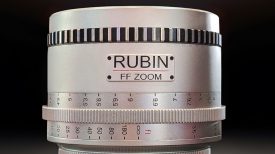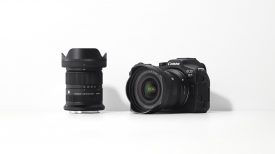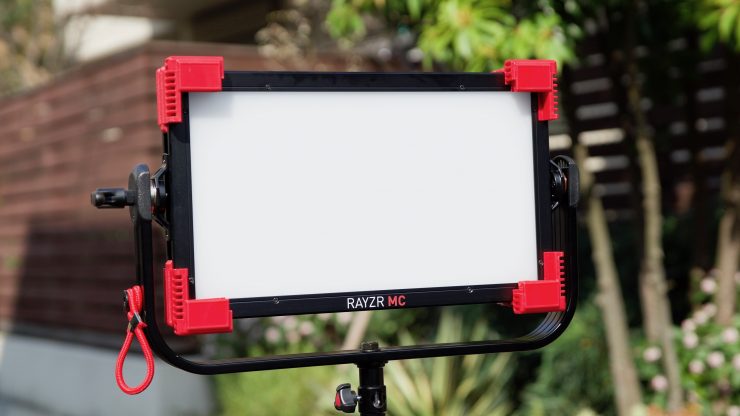
The Rayzr MC panels consist of three new RGBWW LED Soft panels. The MC (MultiColor) Series are fully color tunable, offer a wide Kelvin color temperature range and can be run off camera batteries.
Rayzr is a company from the Netherlands (the lights are made in China) that have been around for a few years now. They originally came out with budget friendly, high output LED fresnels with their RAYZR 7 models, and the MC series is their first foray into panel lights.
Meet the Rayzr MC
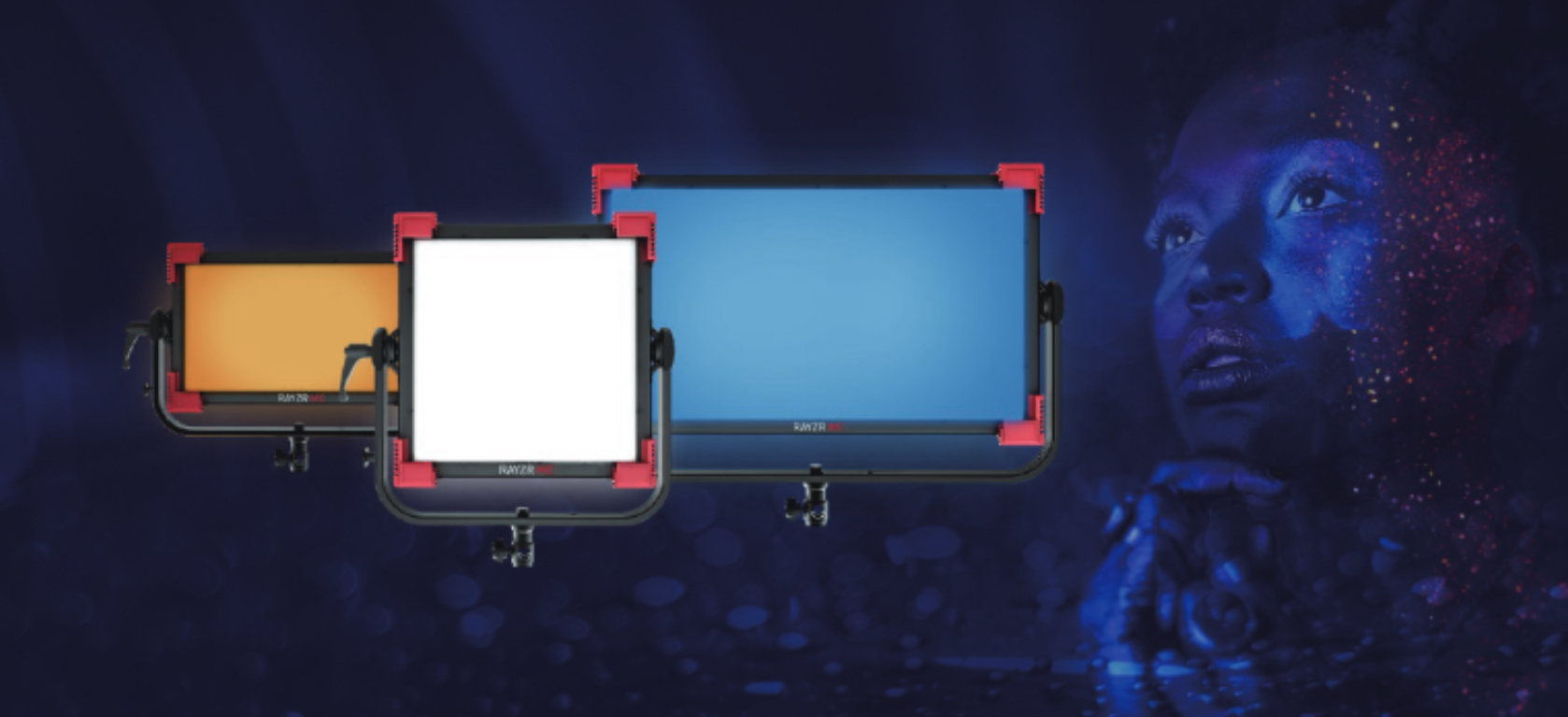
The three lights in the Rayzr MC series are the MC 100, MC 120, and the MC 200. They all offer the same functionality, the only difference is the size and the power draw.
The Rayzr MC series are soft panel fixtures that combine daylight, tungsten, and red-green-blue LEDs.
The Rayzr MC lights come with a host of features, and not only are they Kelvin color temperature adjustable from 2400 to 9900K, but they also feature plus/minus green control, effects, and a library of 300 digital gels.
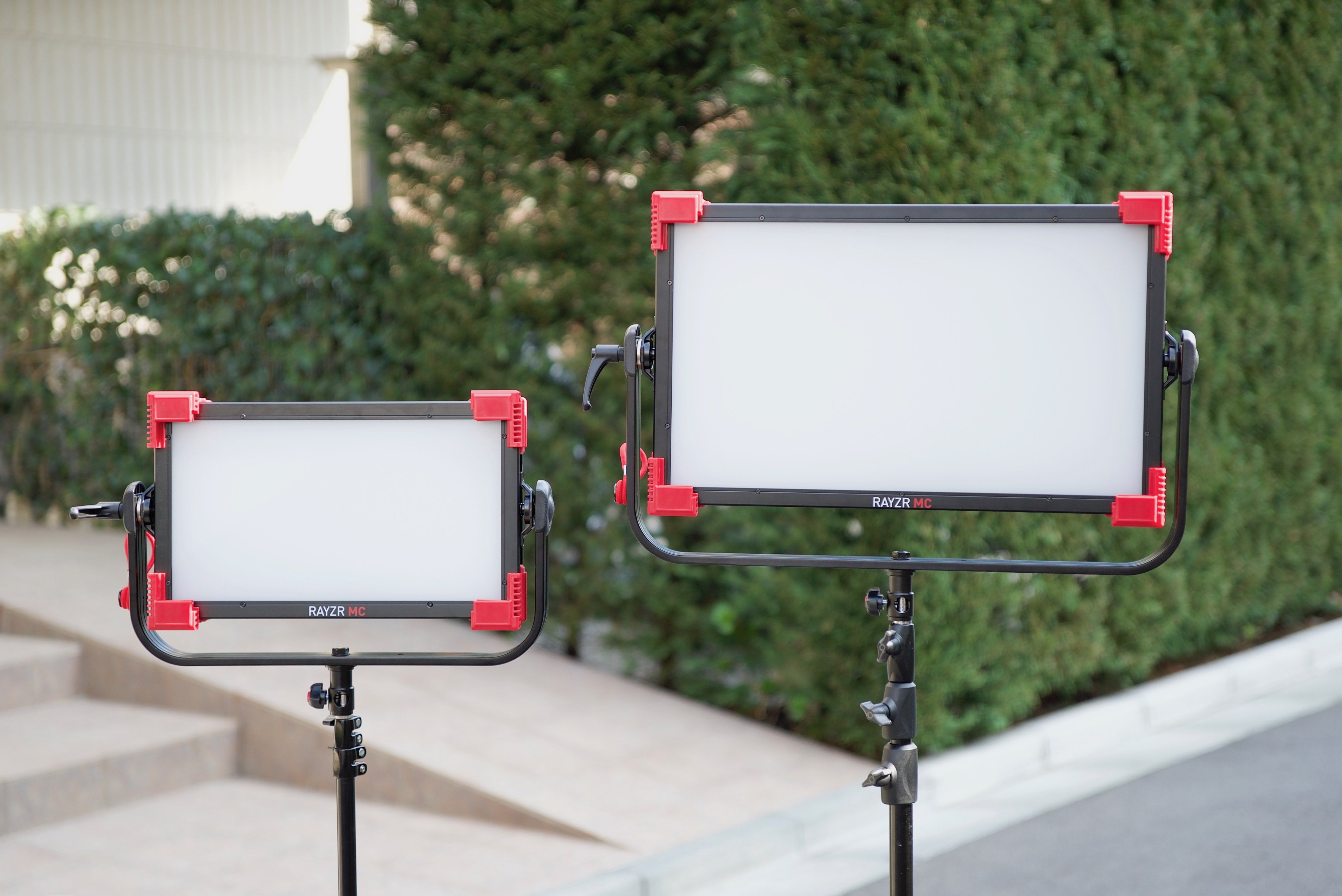
In this review, I got to test the MC 100 and MC 200.
How does RGBWW work?
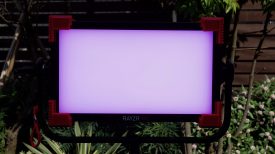
We are seeing a lot of lighting companies now using RGBW technology. RGBW stands for Red, Green, Blue & Warm White. There are, however, other types of RGB such as RGBWW and RGBAW. The Rayzr MC fixtures use RGBWW, which consists of 5 chips, not 4. The extra chip means the Rayzr MC lights not only have a warm white chip, but also a white chip. This is different to say the ARRI SkyPanel where they are actually mixing colors to obtain white. RGBWW can also be found in lights such as the Litepanels Gemini.
RGBWW and RGBW are still not that common as far as LED lights go, mainly because they are a lot more expensive to produce than regular RGB LEDs. While in theory, an RGBWW LED should be better at creating color mixes, it requires significantly more cooling than a regular RGB LED.
Operating Modes
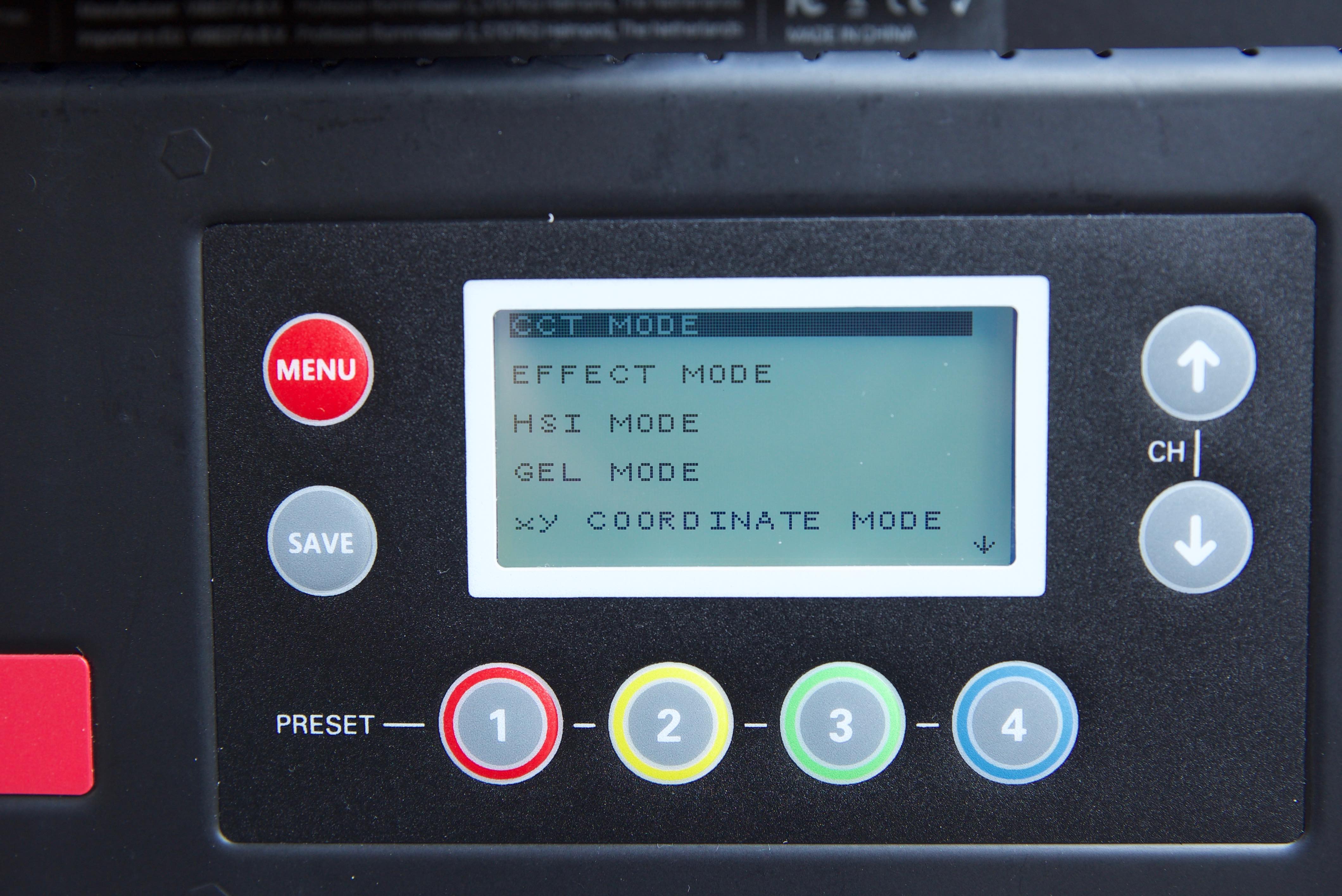
Rayzr MC Lighting Modes
- Color Temperature (CCT) Mode
- HSI Mode
- X, Y Coordinate
- RGBWW Mode
- Gel Mode
- Effects Mode
CORRELATED COLOR TEMPERATURE (CCT) MODE
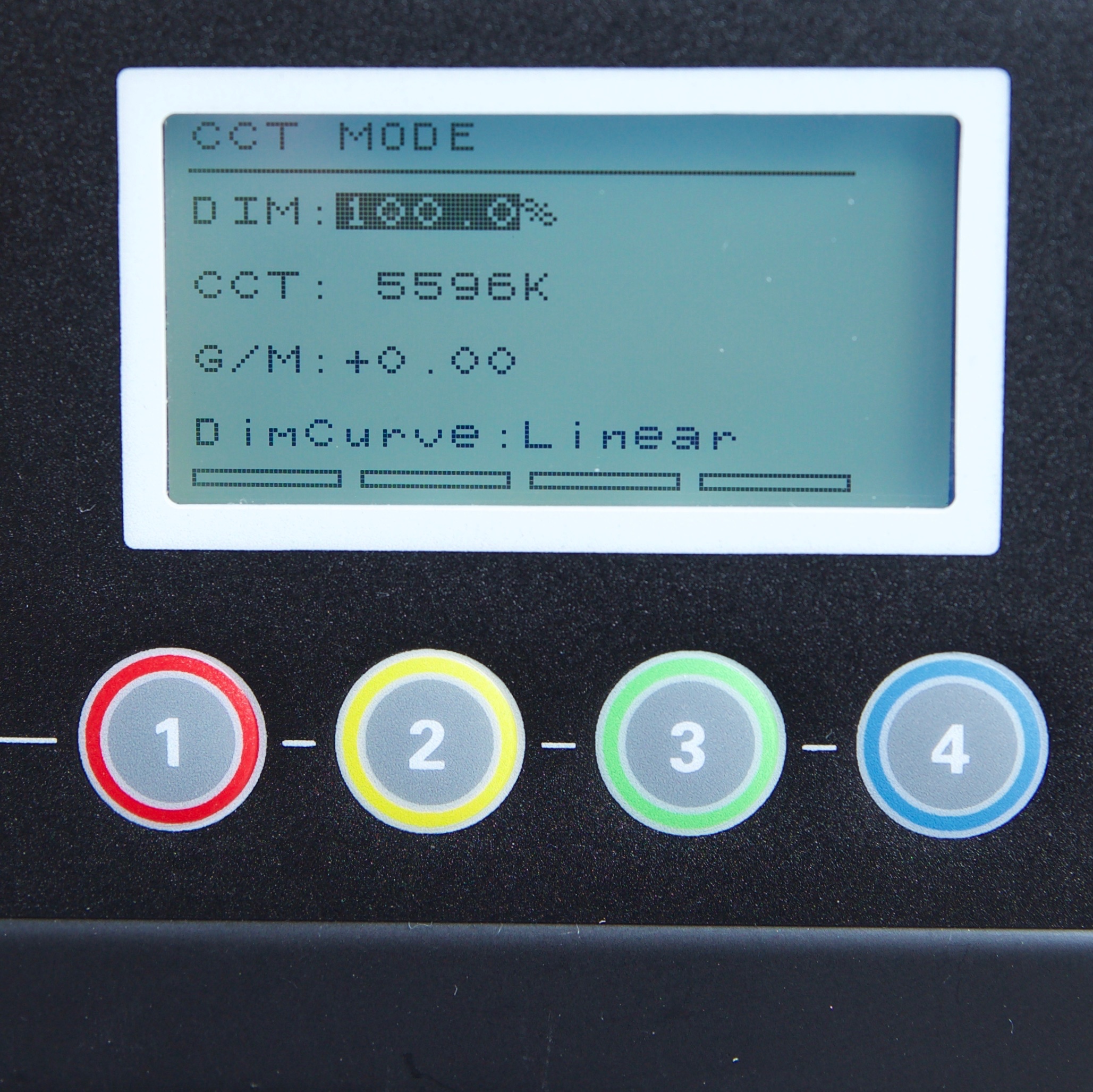
This is the mode most people are going to use the light in. In the CCT Mode, you have full access to making Kelvin color temperature adjustments between 2400K to 9900K. These adjustments can be made in small or large increments depending on which dial you use. You also have full +/- green adjustment available which is extremely handy.
Being able to dial in more or reduce the amount of green coming from your lighting source can make a huge difference. Different camera companies use different sensors in their cameras and they all react differently to light. Some camera sensors may lean towards magenta, and some, more towards green. By making CCT adjustments you can dial in the light so that it looks better for whatever camera system you are using. CCT adjustment also helps when you are
The Kelvin color temperature range is very impressive and the adjustment range is the largest I have seen so far on an RGBWW light.
HSI Mode
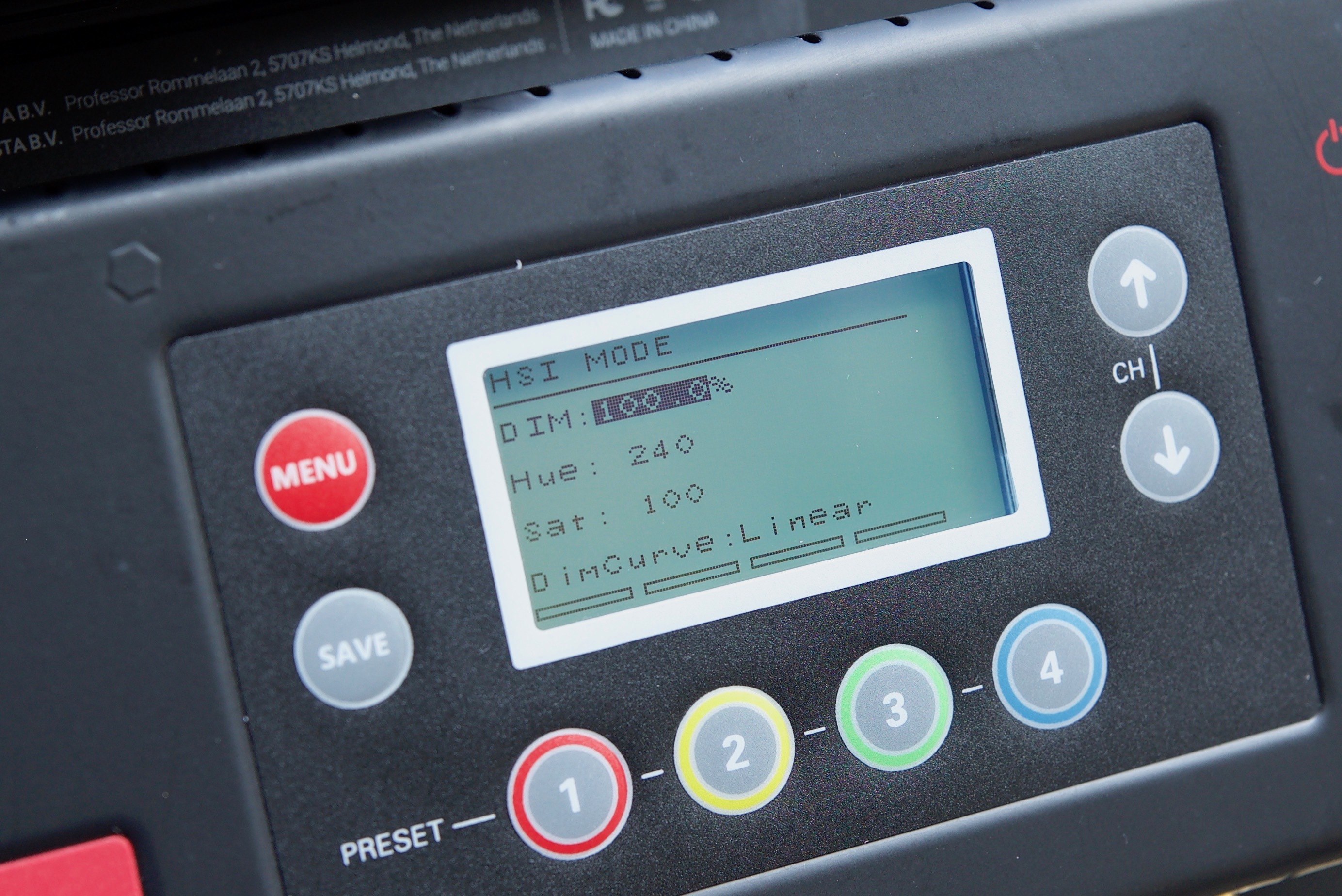
The HSI mode lets you create just about any color you can think of. It gives you full hue and saturation control as well as intensity. By manipulating, the hue and saturation you can create some really interesting colors that depending on the project you are working on can really add some creative flair. I quite like using this mode to create a lot of color separation between the foreground and background, or for recreating a really cold or warm looking image.
X, Y Coordinate
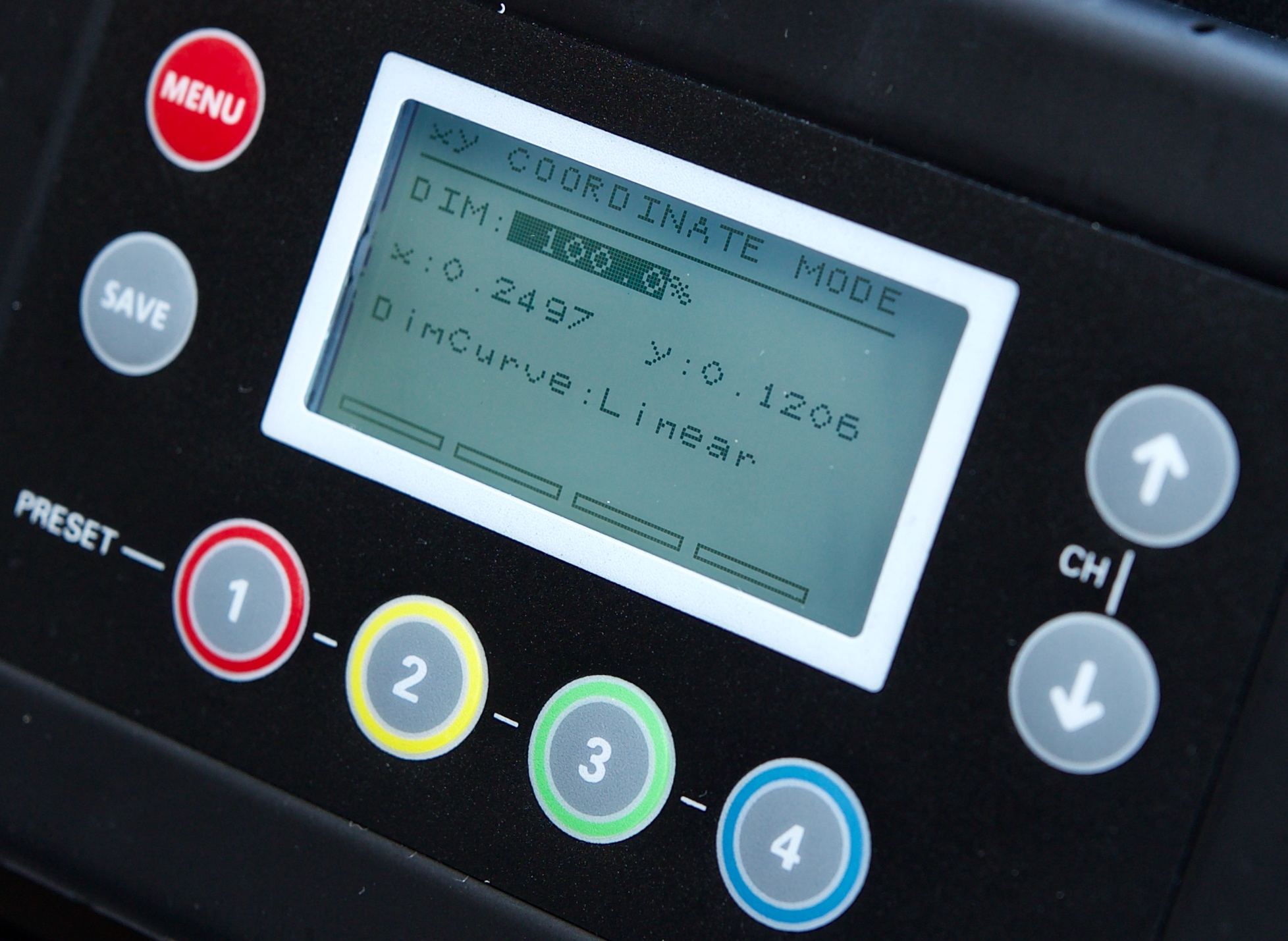
In this mode, you can create colors by changing the X and Y coordinate axis. This gives you more finite control for creating colors than using the HSI Mode.
Digital Gels
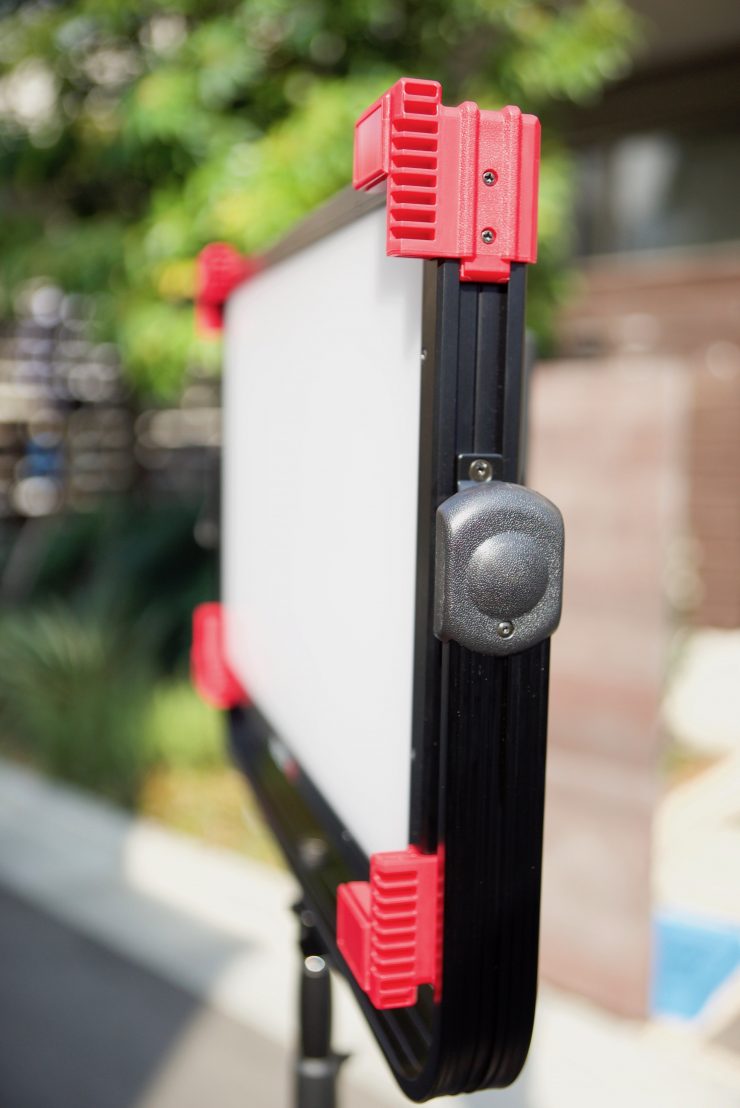
Inside the fixture, there are 300 Digital Gels. Rayzr claims that there is no light loss when using any of the gels. Having built-in Digital Gels not only means that you don’t have to physically carry gels around, but you can also quickly and easily replicate popular gels. Using the gel mode can help you match other lighting sources, especially if you are working with other lights with gels.
RGBWW Mode
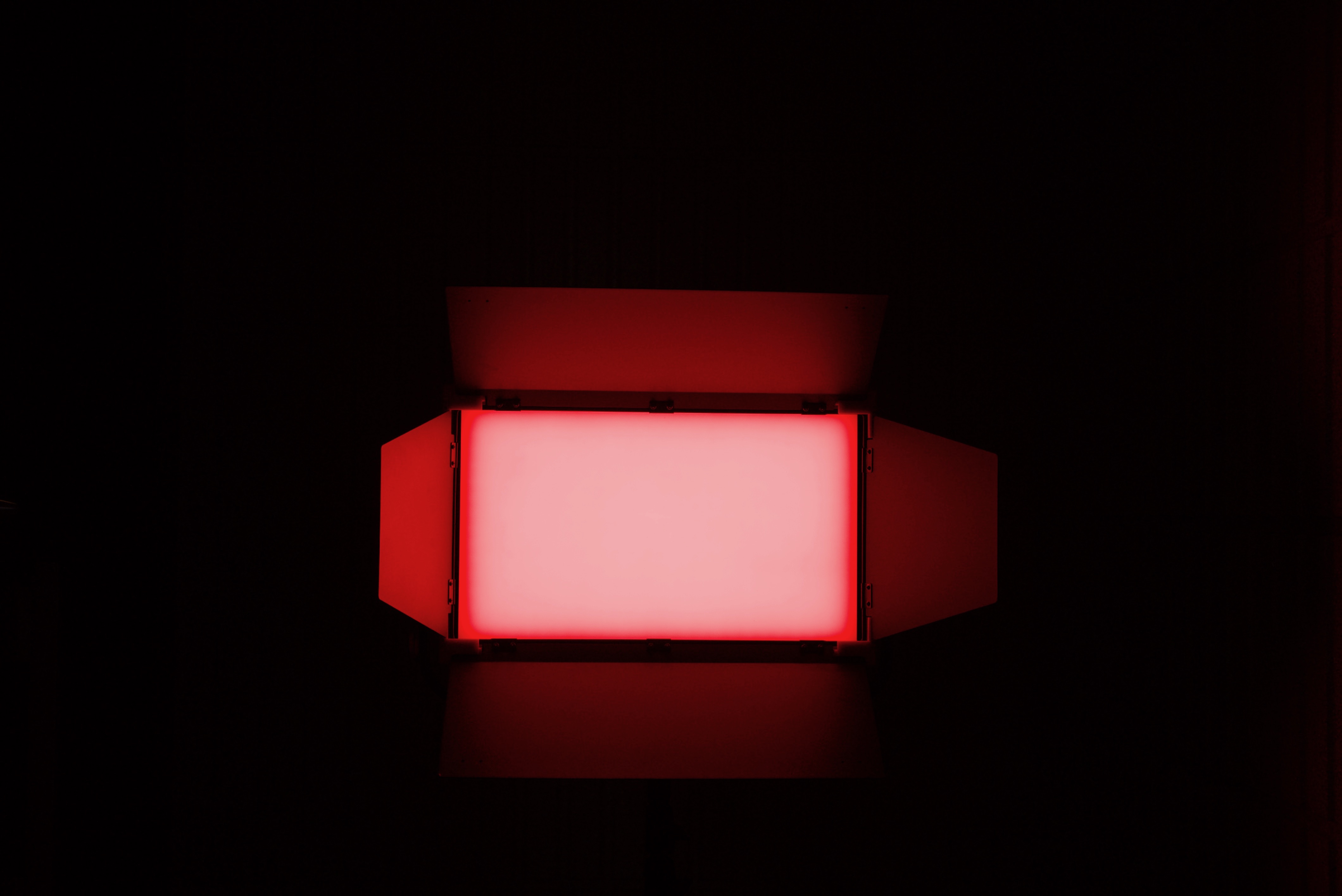
In his mode, you have full control over how much Red, Green, Blue, White, and Warm White are being used. This way you can mix various color combinations to achieve a certain color you are after.
Effects
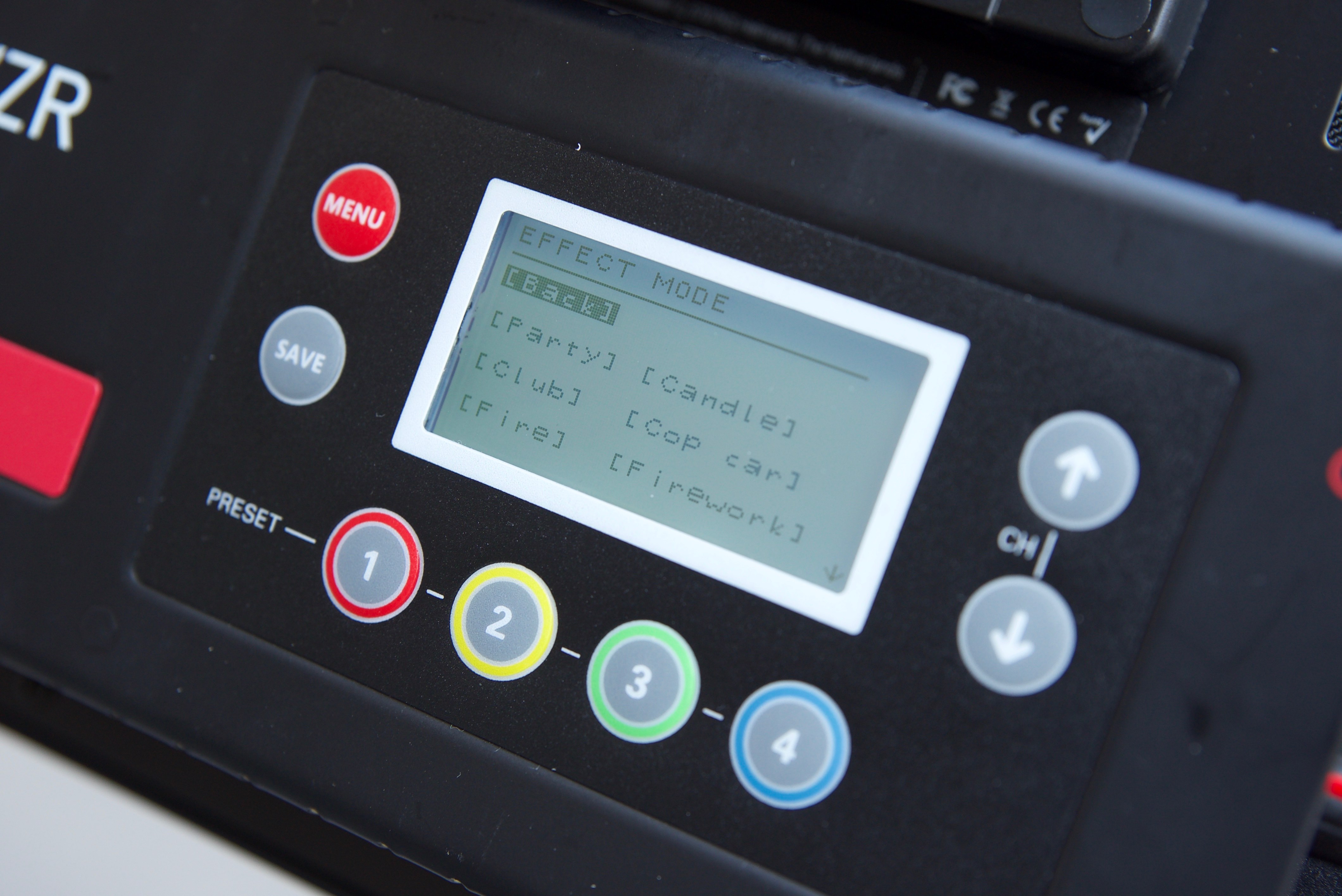
The Effects mode lets you recreate a wide range of lighting effects which can be handy for certain scenarios. The effects include:
- Party
- Candle
- Club
- Cop Car
- Fire
- Fireworks
- Light Strobe
- Lightning
- Television
-
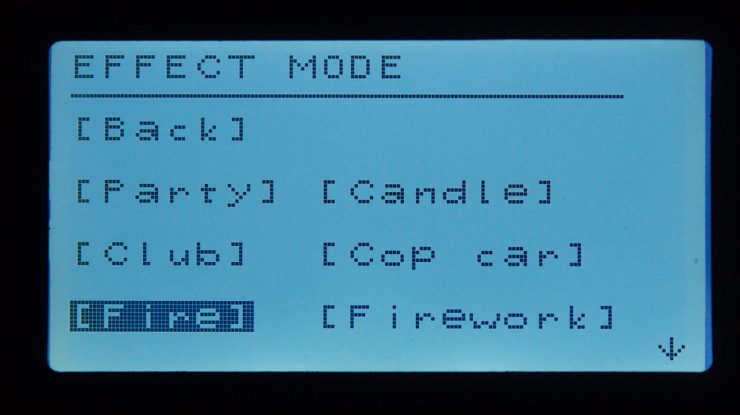
Select effect -
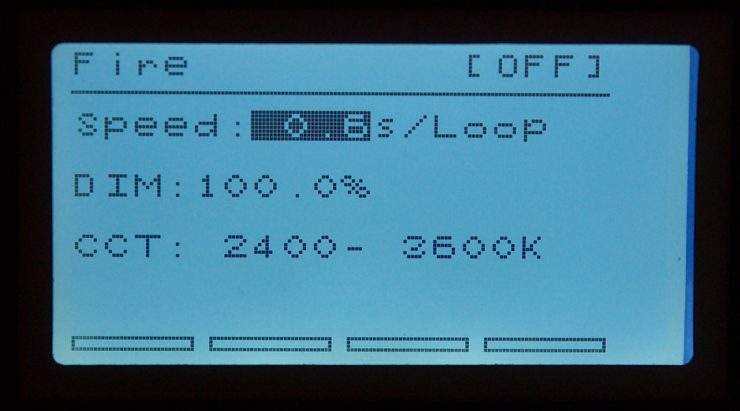
Adjustment parameters -
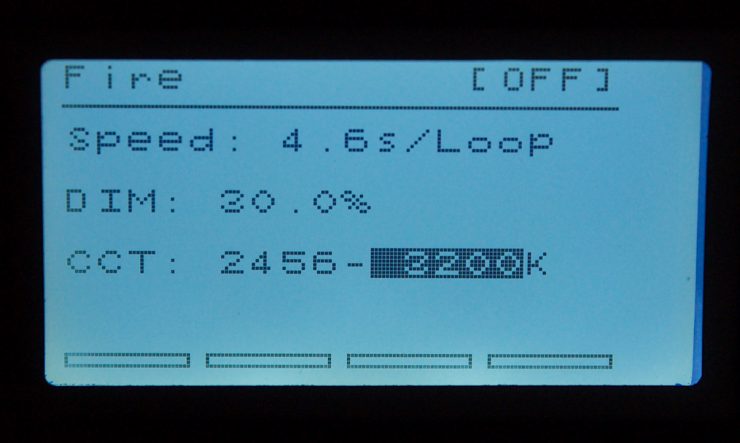
Make adjustments
All the effects modes can be individually adjusted and tailored to your lighting needs.
Most of these features are hardly revolutionary
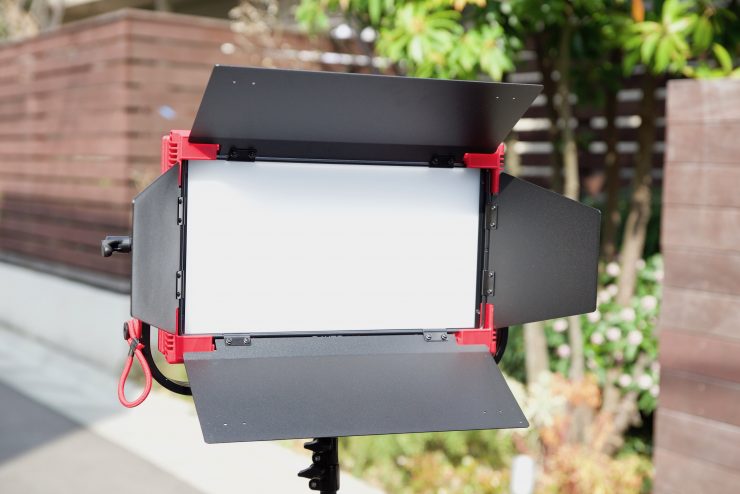
There doesn’t seem to be that much imagination from lighting companies. Most of today’s RGB lights all seem to have the same or very similar feature sets.
While all these options are great, they are hardly revolutionary features. +/- green adjustment, hue, saturation and intensity (HSI) control, the ability to dial up gels, and lighting effects have been available in the Arri SkyPanel series and a few other RGBW, RGBWW, and RGBAW lights for quite some time.
Design
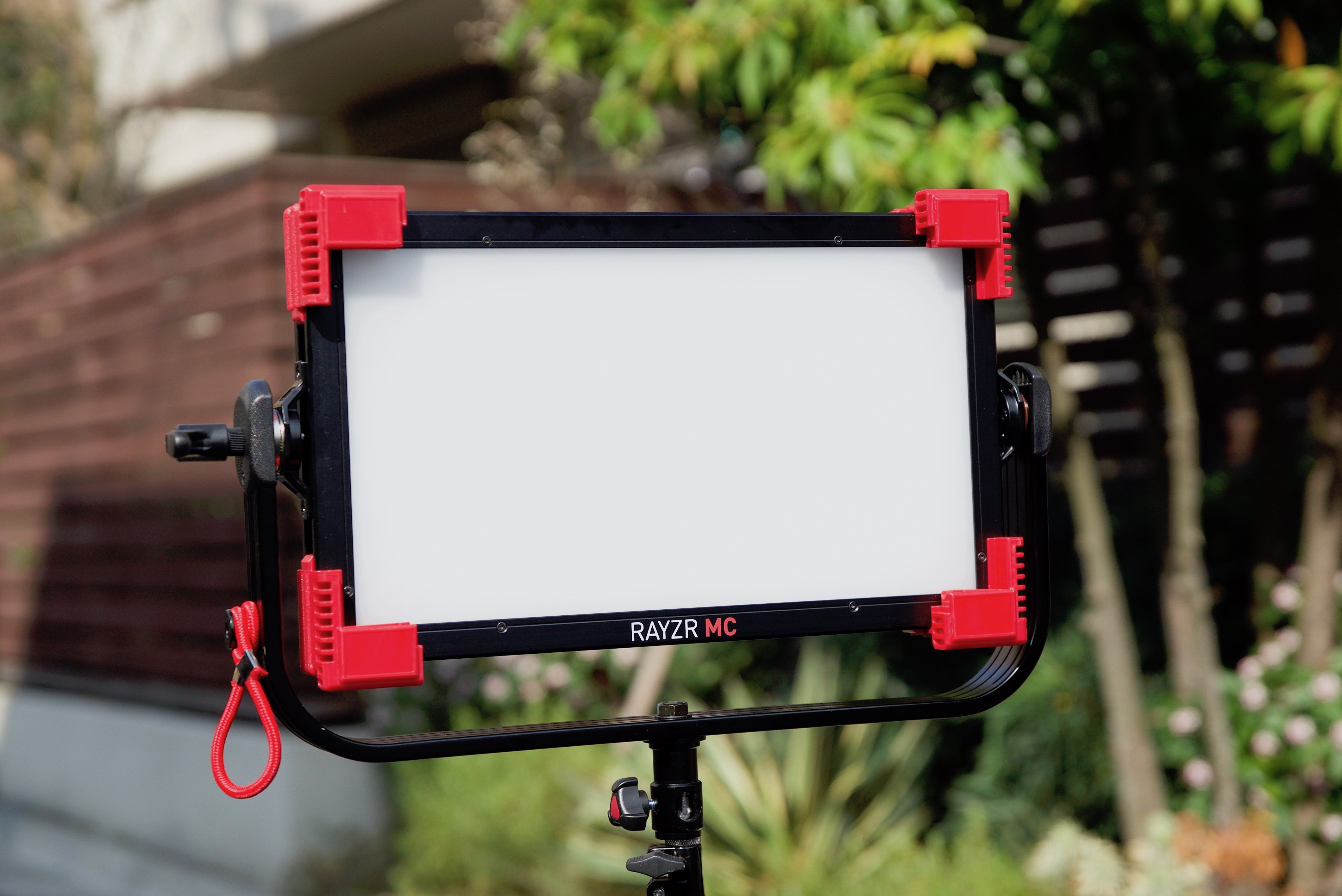
As far as the design goes, a panel light is a panel light. There are only so many ways you can design and build one. In a way, the Rayzr MC series looks fairly similar to a lot of other competing options.
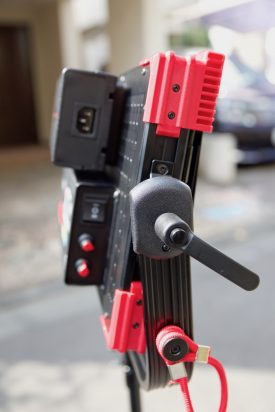
I like that the MC series are all self-contained units where everything is attached to the fixtures. This way you can just pull the lights out of a bag, put a battery on the back and you are ready to go. In that regard, the lights are very suitable for shooters working in fast-paced environments.
I’m not the biggest fan of lights that consist of multiple components that you have to assemble and connect together.
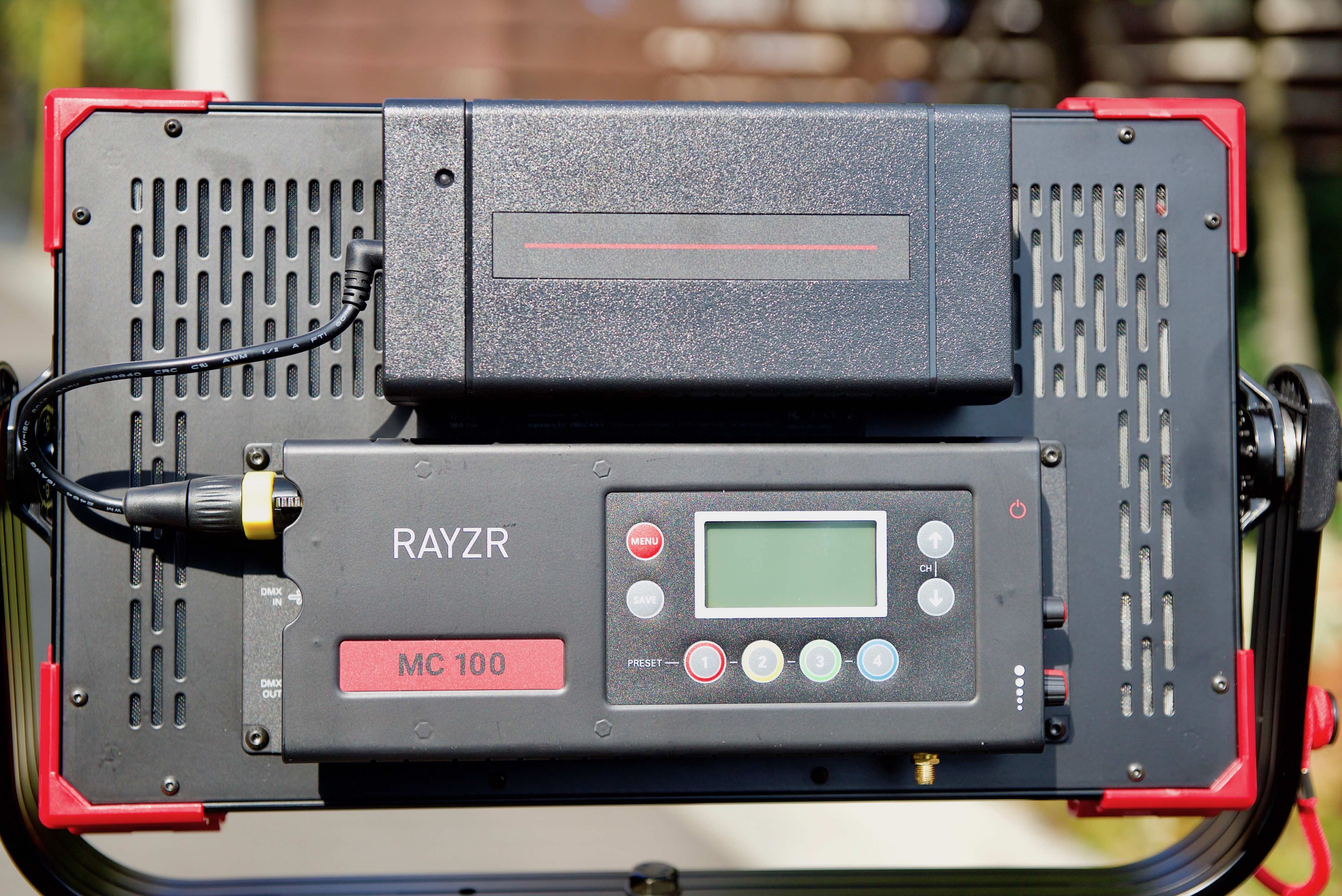
The control unit looks almost identical to those you would find on some of the Kino Flo lights, right down to the color and placement of the buttons. I personally don’t like when companies make products that are almost identical to someone else’s. Is there a reason as to why it looks so similar to a Kino Flo control unit? Well to find this out I asked Rayzr for a comment and I was told: Regarding the shape of the control unit and even the position of the display and buttons, this is already mainly decided by the position of the inputs and the board. Even though the design is similar, it’s by no means a copy, as the way to control the light is completely different from Kino Flo. We design the controllers in a way that we think makes sense for the user.
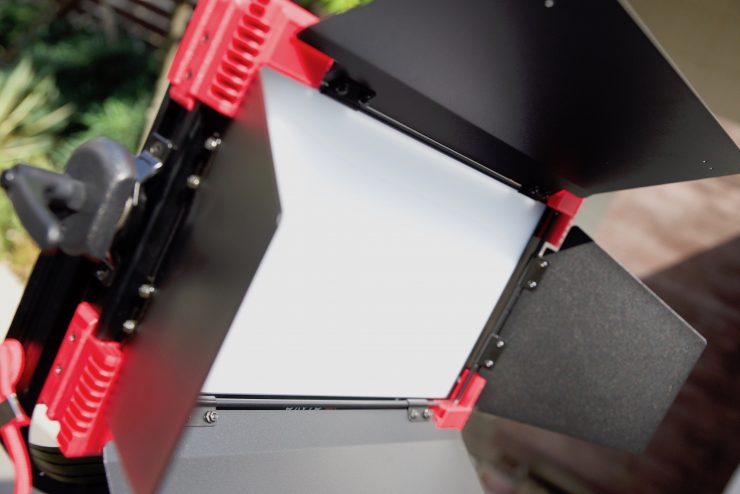
The lights all come with barn doors which is something you don’t normally get as standard.
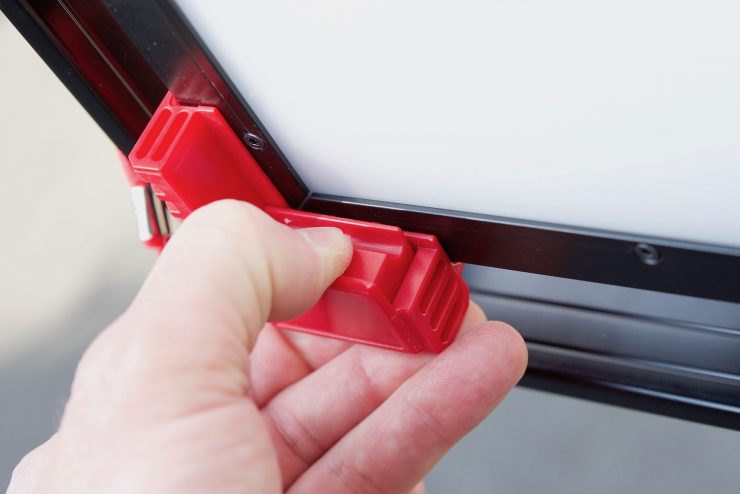
The lights also use a Quick Release Accessory System that lets you mount light shaping tools such as honeycomb grids, barn doors or a softbox. This is quick and easy to use. This system uses a simple spring mechanism and it makes taking off or putting on accessories like the barn doors very easy. It has been well designed and once your preferred light shaping tool is in place it won’t move around or rattle.
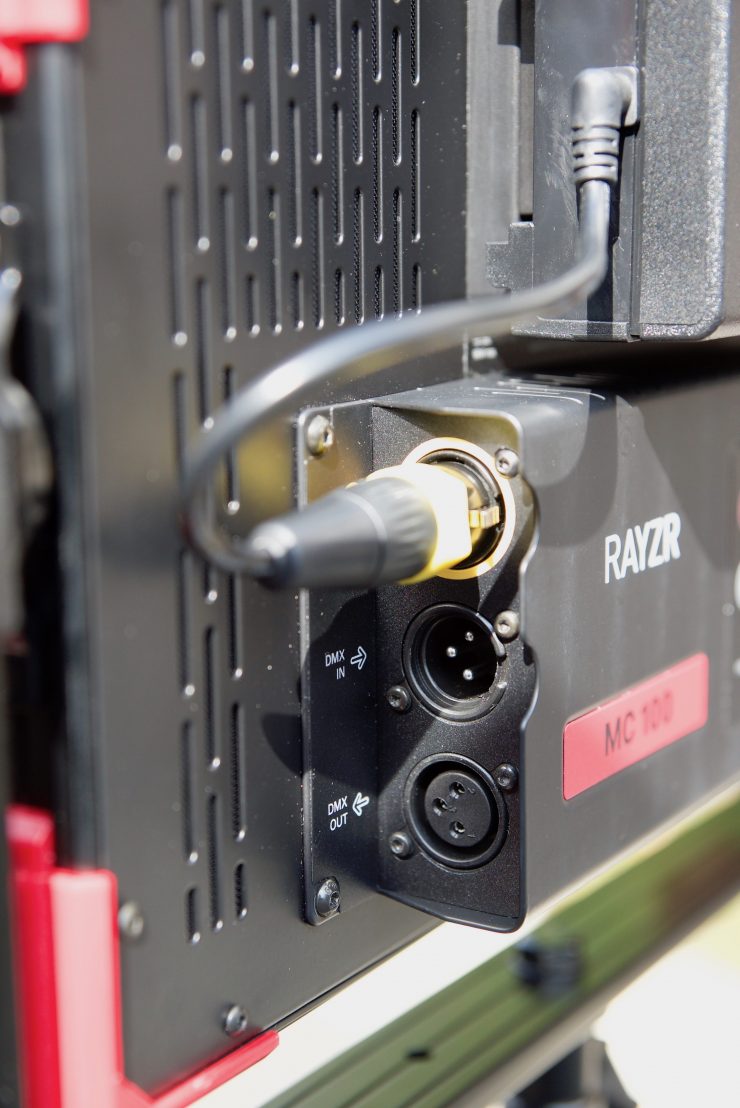
The MC series give you both wireless control as well as DMX. With WiFi and DMX built-in, the MC series is easy to control if you need to use them remotely. WiFi will work through a router, and Rayzr makes the platform compatible so that you can use any universal router. The WiFi will work with ArtNet so any App compatible to ArtNet like Luminair 3 can be used.
Controls and Menu System
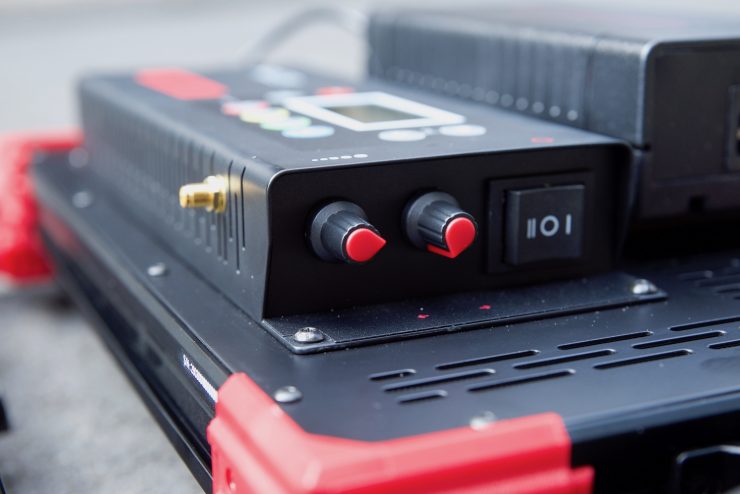
I like the controls and menu system on the Rayzr MC. Everything is easy to access, and the menu system is straightforward and easy to use. The buttons and dials are clear and easy to read and the in-built LCD display shows you exactly what you need to see. The dials have little notches on them so when you make adjustments you get a nice tactile feeling.
Preset Buttons
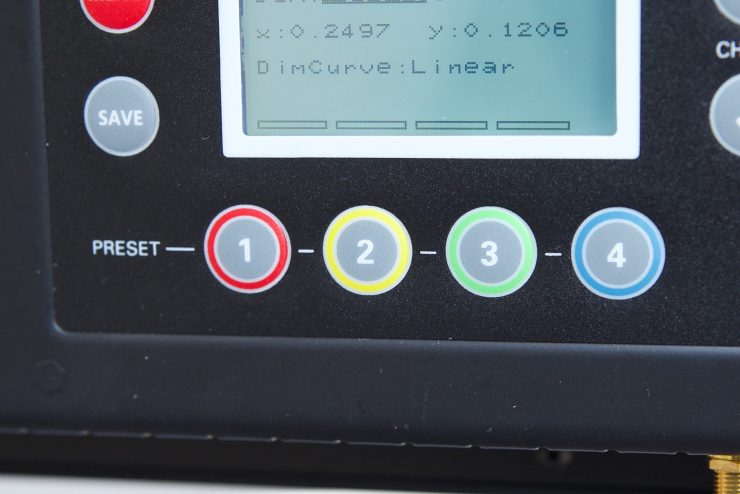
The MC series lights have four preset buttons that in the default mode are set as Kelvin color temperature presets: 3200K, 4500K, 5600K, and 6500K. You can save your own Presets but Rayzr have made this a little confusing. You can only save presets when you are in a particular mode. If for instance, you are in the HSI mode, you can only save various HSI settings and assign them to the presets. If you then move to say the CCT mode the presets are not the same as when you were in the HSI Mode. While there is nothing wrong with this, there is no way of knowing what you have set as presets in all of the individual modes unless you have a photographic memory. If you are going to store presets I suggest you write them down somewhere.
The nice thing about presets is that if you are working with certain cameras and you have pre-dialed in a look that you know works well with that camera, you can just store it and then bring it up the next time without having to adjust all the settings. This saves precious time and allows for accurate repeatability with your lighting.
Dimming Curves
Four user-selectable dimming curves provide fine-grained control in specific situations:
- Linear– being a 1:1 translation
- Exponential– providing fine control in the low end
- Logarithmic– provides fine control in the high end
- “S” Curve – is a combination of exponential and logarithmic
Build Quality
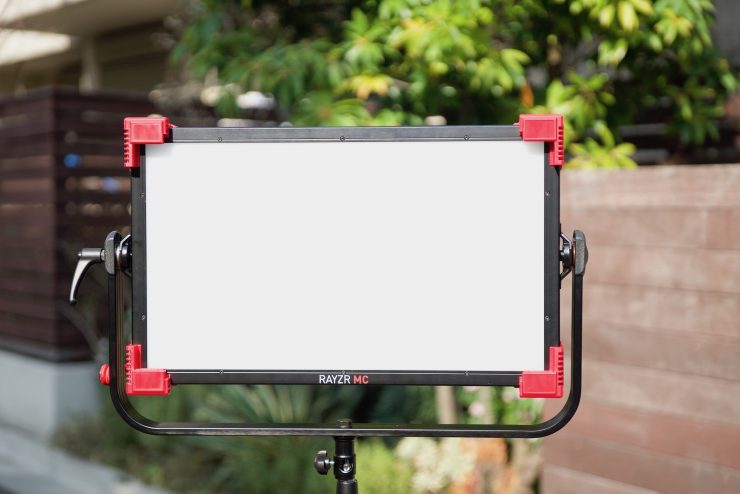
The Rayzr MC panels are solidly made and after going over the LED panels with a fine tooth comb I don’t have any concerns about the build quality.
The lights housing is mainly constructed using an aluminum profile frame and all the dials and buttons have a nice tactile feel. I was impressed by the overall attention to detail and the quality of the finish
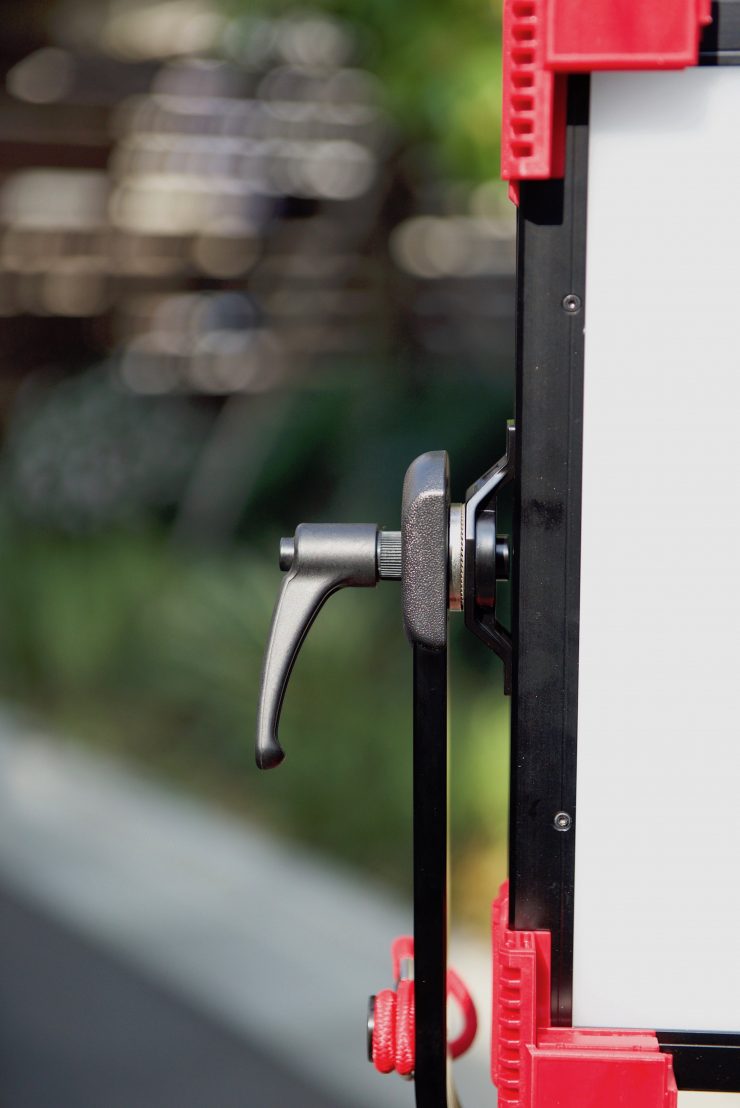
The yolk frame is nice and robust and offers a full range of rotation. It locks off very securely and the tightening lever uses a type of grooved rosette connection so it won’t slip or move. The locking mechanism is one of the best I have seen on a LED light.
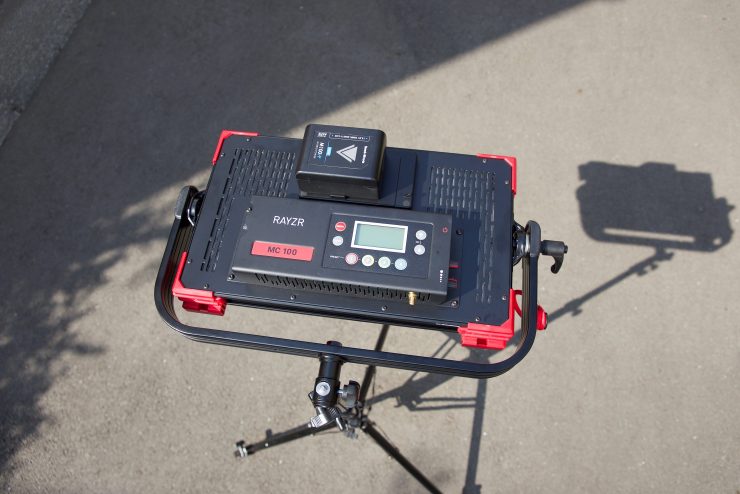
What I do like is that Rayzr has put two mounting points on the light stand receptor so you can mount the lights horizontally or vertically. I’m not sure why more lighting companies don’t do this.
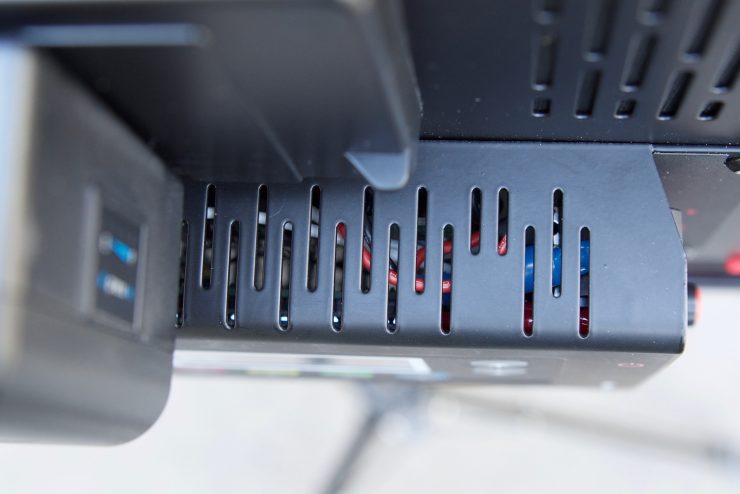
The light doesn’t look that well suited for use out in the elements if it is raining or snowing for instance. There is a lot of exposed vents on the control unit and you wouldn’t want any type of liquid or moisture getting inside.
Even though it looks to be built really well it’s impossible for me to say how it would hold up over time.
No Fan
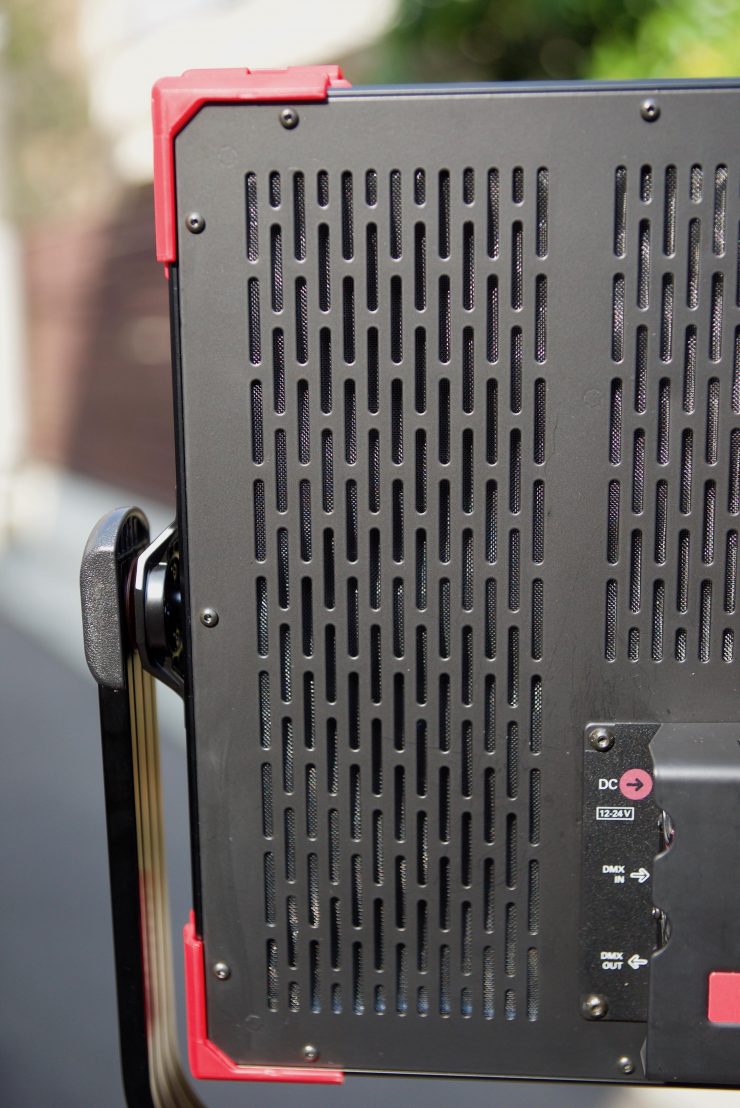
The Rayzr MC doesn’t use a fan, instead, it relies on passive cooling. This is quite rare for an RGBWW light, in fact, there are very few RGBWW lights that don’t use a fan. The metal housing of the MC Series is designed and optimized for passive cooling through efficient internal airflow as well as acting as a heatsink. The MC100, 120 and 200 all feature fan-less designs.
I did, however, find that if you are running the lights for long periods of time the back of them does get hot. It’s not too hot that you can’t touch it, but it does get warm.
Size and Weight
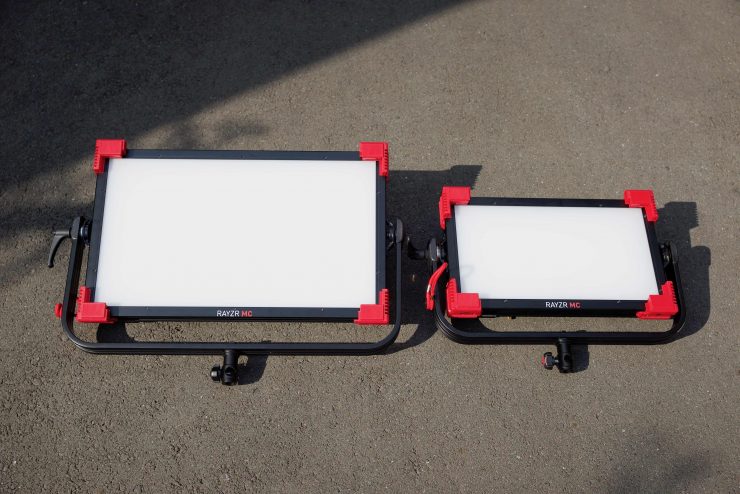
The Rayzr MC 100 has dimensions of 50cm x 34.5cm x 9.3cm and weighs in at 3.5kg (7.7lb), which is certainly heavy for a light of this size. The Rayzr MC 200 has dimensions of 63.2cm x 44.1cm x 9.3 cm and it weighs 4.6kg (10lb). The Rayzr MC 120 tips the scales at 3.4kg (7lb) and it has dimensions of 42.3cm x 44.1cm x 9.3cm.
In the case of the MC 120, this is how it compares to some other 1×1 style RGBW lights in terms of weight:
- Lupo Full Color 30 – 3.7kg (8.15lb)
- Luxli Timpani – 3.15kg (6.95lb)
- BB&S Area 48 Color- 4.6 kg (10lb)
It’s hard for me to compare the MC 100 against anything else because it’s not a 1×1 panel. Likewise, the MC 200 isn’t a 2×1 panel either, it is sort of stuck in between a 1×1 and a 2×1.
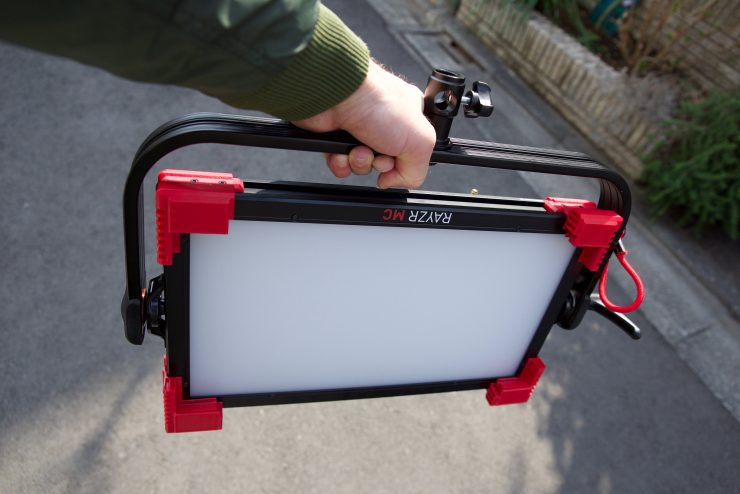
Given the feature set and build quality, the weight is well controlled. In the case of the MC 100 it’s nice to have an RGBWW fixture that is this size. For a traveling shooter who is looking for a compact RGBWW solution, the MC 100 certainly makes a lot of sense.
Power Draw
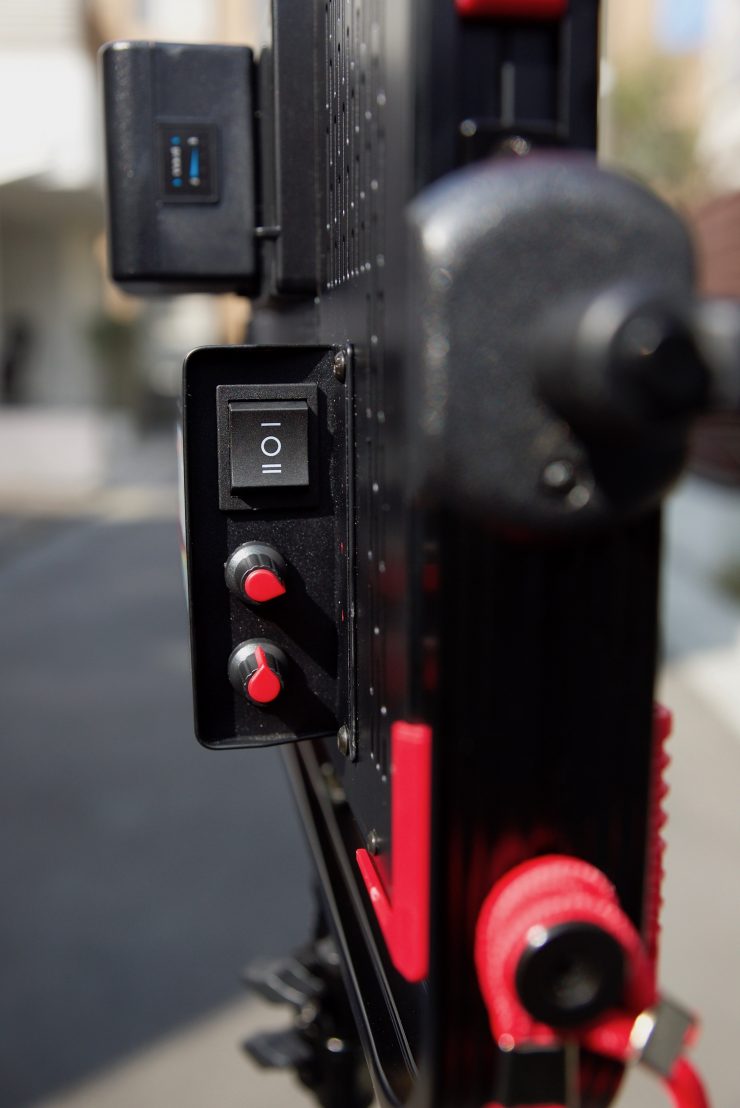
The Rayzr MC 120 draws 118W and can be run off mains power or by using a camera battery via the included V-mount battery plate. This power draw is way lower than that of the Lupo Superpanel Full Color 30 and ARRI S30-C Skypanel (both draw 200W), and the 165W of the BB&S Area 48 Color. The Luxli Timpani draws 120W.
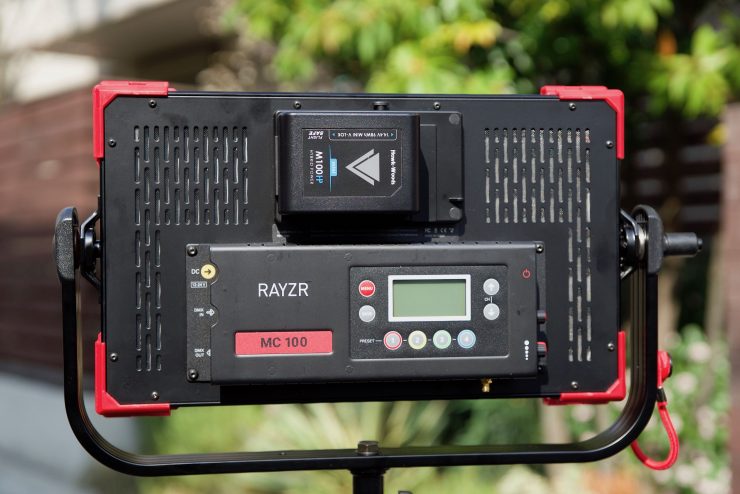
The Rayzr MC 100 draws just 98W, which makes it a very travel-friendly solution. Having any light that can be run off a single camera battery that is under 100Wh is a big deal if you are traveling.
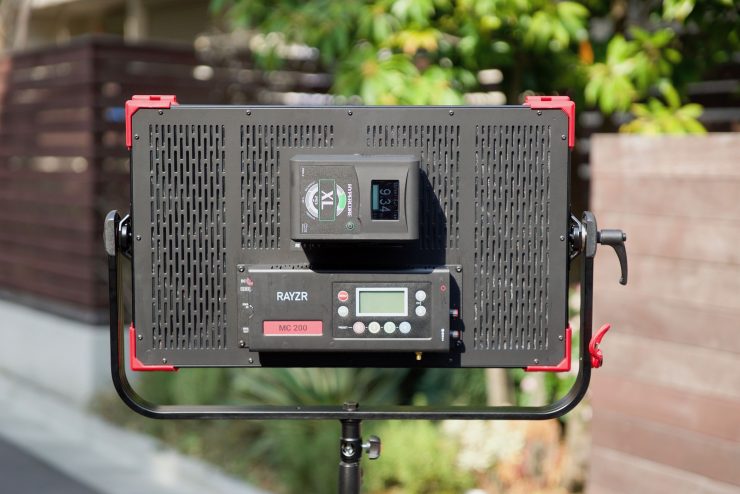
The Rayzr MC 200 draws 190W of power which makes it a little more tricky to use remotely out in the field. Although, in saying that, it does draw less power than the slightly smaller Lupo Superpanel Full Color 30 and ARRI S30-C SkyPanel (both 200W).
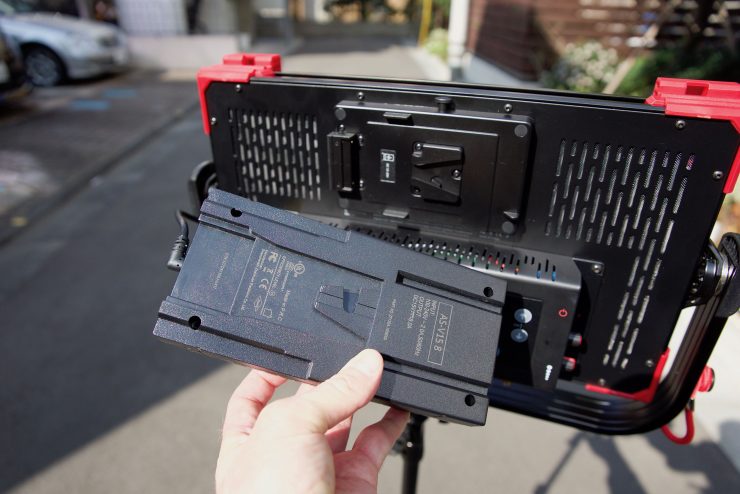
All three MC fixtures can be used on location without mains power, which is always handy. I like how Rayzr has integrated the V-lock battery plate on the fixtures and this is also where the AC power supply gets mounted. This is a very clever design and it makes switching between mains and battery power a very simple, and most importantly, quick process. Most people buying 1×1 style LED panels want to be able to attach a battery straight onto the back of the fixture. They don’t want to be messing around with mounting brackets.
Beam Angle
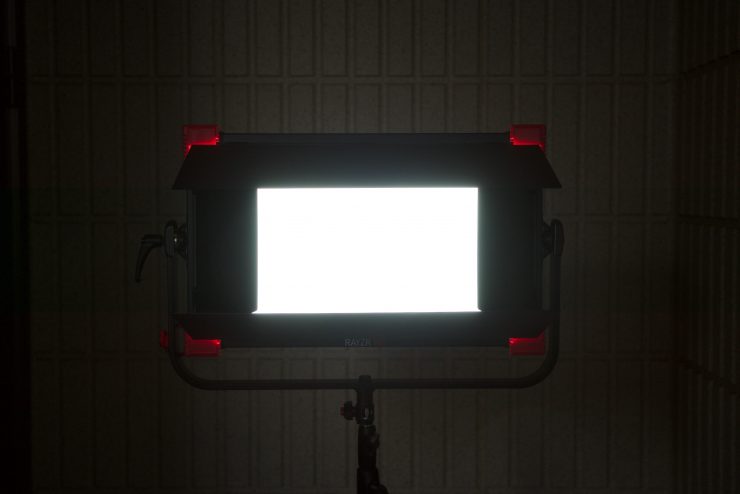
All three of the Rayzr MC Soft panels have very wide 120° beam angle. Having a wide beam angle makes these fixtures very versatile. The only real downside to a wide beam angle is that if you are using the lights for interviews or scenarios you need to control the spill. While this can be done fairly effectively with the barn doors, a honeycomb grid will probably get you better results.
In comparison, the Lupo Full Color 30 has a 115-degree beam angle, the Luxli Timpani has a beam spread of 72-degrees, and the BB&S Area 48 Color is 105 degrees.
Flicker Free
If you are shooting at high frame rates you don’t want your lights to flicker. The MC series let you shoot at any frame rate and shutter angle without flicker. The base frequency of the MC series can be adjusted to provide high-speed performance at any setting.
They are not Firmware Upgradable…. yet.
Unlike some other RGBWW lights that are available, the Rayzr MC panels are not firmware upgradable…yet. Firmware upgrades will eventually be possible, but this will need to be done either by Rayzr or a service partner. Rayzr told me that are working on making it possible through Wifi as well as by the user.
Photometrics
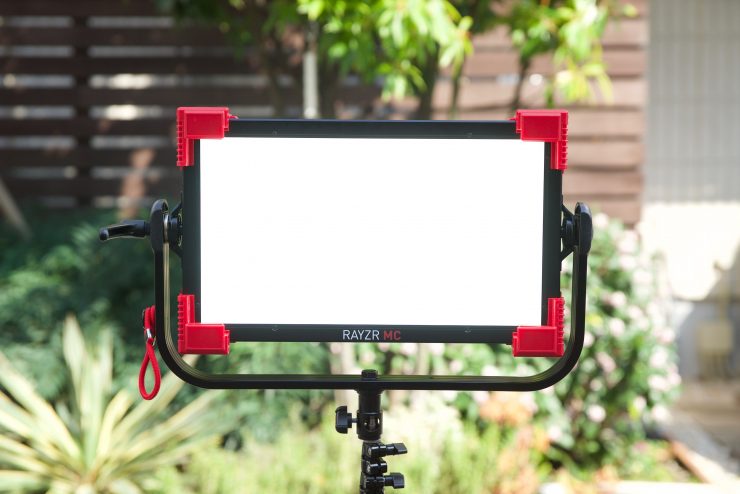
So now let’s get to the photometric results. I always test lights in this way so that I get a reference to how they compare to other fixtures. Results only tell part of the story and should never be used alone to judge a light. I have found from extensive testing over the years that certain lights that have good photometric results don’t always look good, and lights that have worse photometric scores can sometimes look better than their results indicate.
Output and Color Temperature Accuracy
I tested the Rayzr MC 100 and MC 200 at a variety of Kelvin color temperatures with a Sekonic C-700 Spectrometer to find out how much output the lights had and how accurate the Kelvin color temperature reproduction was. All readings are taken at a distance of 1m (3.28ft) in a controlled environment.
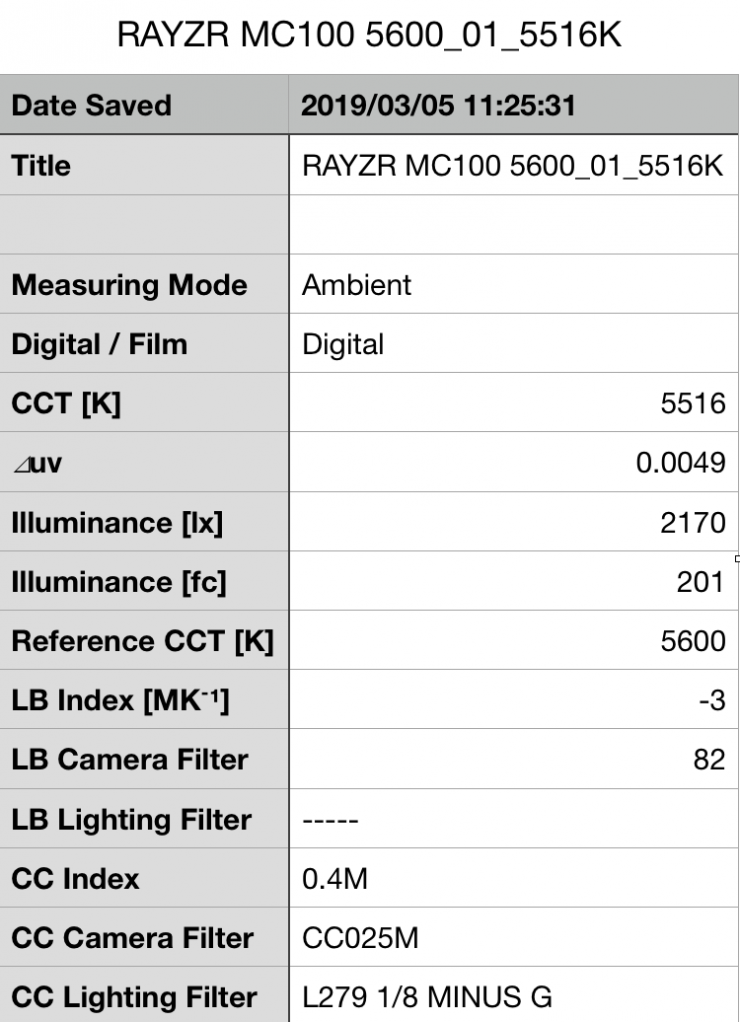
Above you can see the MC 100 recorded an output of 2170 lx (201 fc) when set at 5600K and run off mains power. This is a little lower than the claimed output of 2229lx. The MC 100 produced a Kelvin color temperature of 5516K. The light had a CC Index score of 04M.
How does this compare to some other slightly larger 1×1 style RGB lights:
ARRI S30-C SkyPanel (5950lx at 5600K)
Lupo Superpanel Full Color 30 (3880lx at 5600K)
Luxli Timpani (3380lx at 5600K)
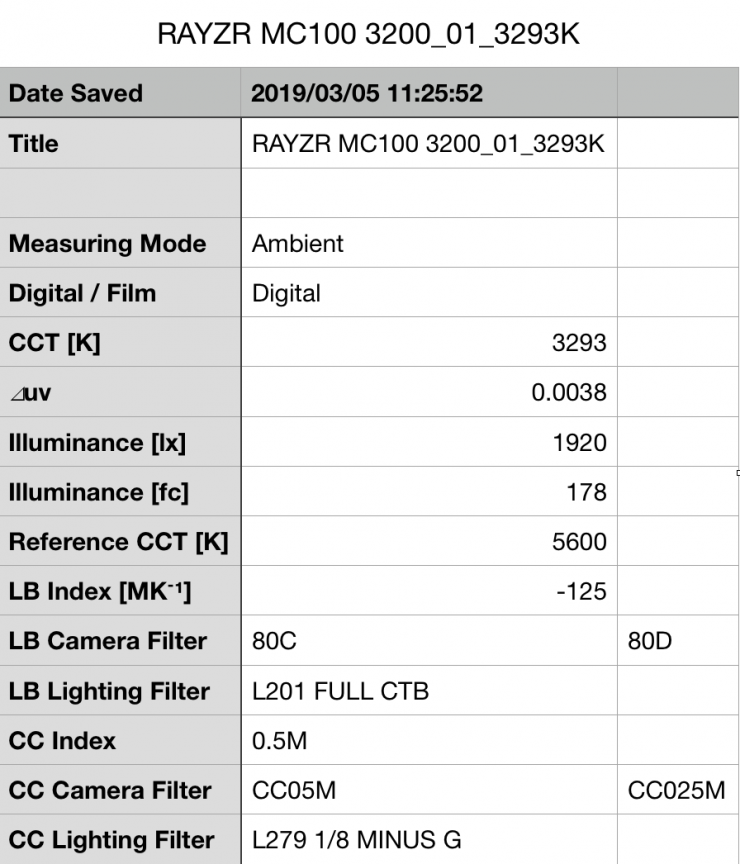
Above you can see the lights output when it was set at 3200K. It produced 1920 lx (166 fc), which is 11.5% less than the 2170 lx it produced at 5600K. As far as Kelvin color temperature accuracy goes, it recorded a fairly accurate reading of 3293K. Just like at 5600K, the reading at 3200K showed a slight push towards magenta (0.5M).
Now, as the light features +/- Green adjustment you can quite easily correct any tint. While there is no exact science to this, and it really depends on what camera you are using as well, it’s just a matter of trial and error to see what setting actually works the best. The nice thing is, any light with +/- Green adjustment can be fine-tuned to deliver better results.
How does it perform at various Kelvin color temperatures?
Summary of results
2400K – 1390 lx (1295 fc) and a Kelvin color temperature reading of 2463K
3200K – 1790 lx (166 fc) and a Kelvin color temperature reading of 3279K
4500K – 2130 lx (198 fc) and a Kelvin color temperature reading of 4513K
5600K – 2170 lx (201 fc) and a Kelvin color temperature reading of 5539K
6500K – 2180 lx ( 202 fc) and a Kelvin color temperature reading of 6615K
9900K – 2030 lx (188 fc) and a Kelvin color temperature reading of 9500K
These results show me that the lights output is fairly consistent at 4500K and above. The output of the light is fairly impressive given its small size and power draw.
The results also show me that the light is very accurate when it comes to Kelvin color temperature reproduction, particularly up to 5600K. When used above 5600K it still does a pretty good job, but it’s still a few 100º Kelvin off when used at some Kelvin color temperatures.
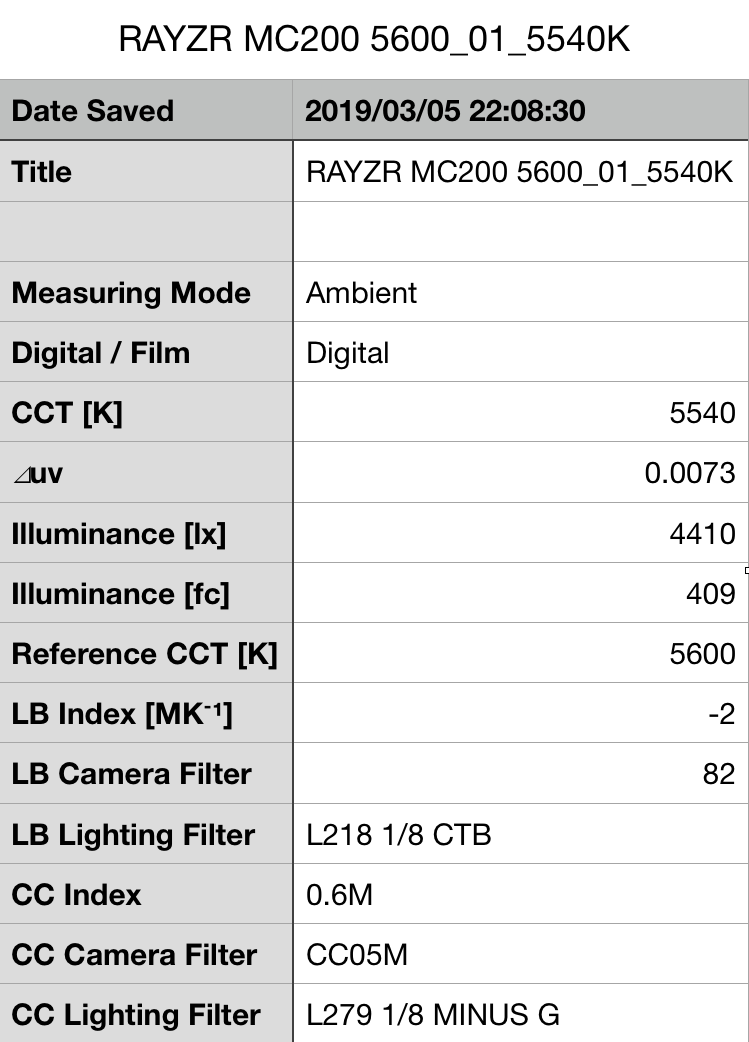
I also measured the larger MC 200 to see how much output it had. Above you can see that when set at 5600K it had an output of 4410 lx (409 fc). This was higher than the claimed output of 4171lx. The MC 200 produced a Kelvin color temperature of 5540K. The light had a CC Index score of 0.6M.
The output of the MC 200 was pretty good for a light that draws 190W. The output was more than some slightly smaller RGBWW lights such as the Lupo Superpanel Full Color 30 (3880lx at 5600K), and Luxli Timpani (3380lx at 5600K)
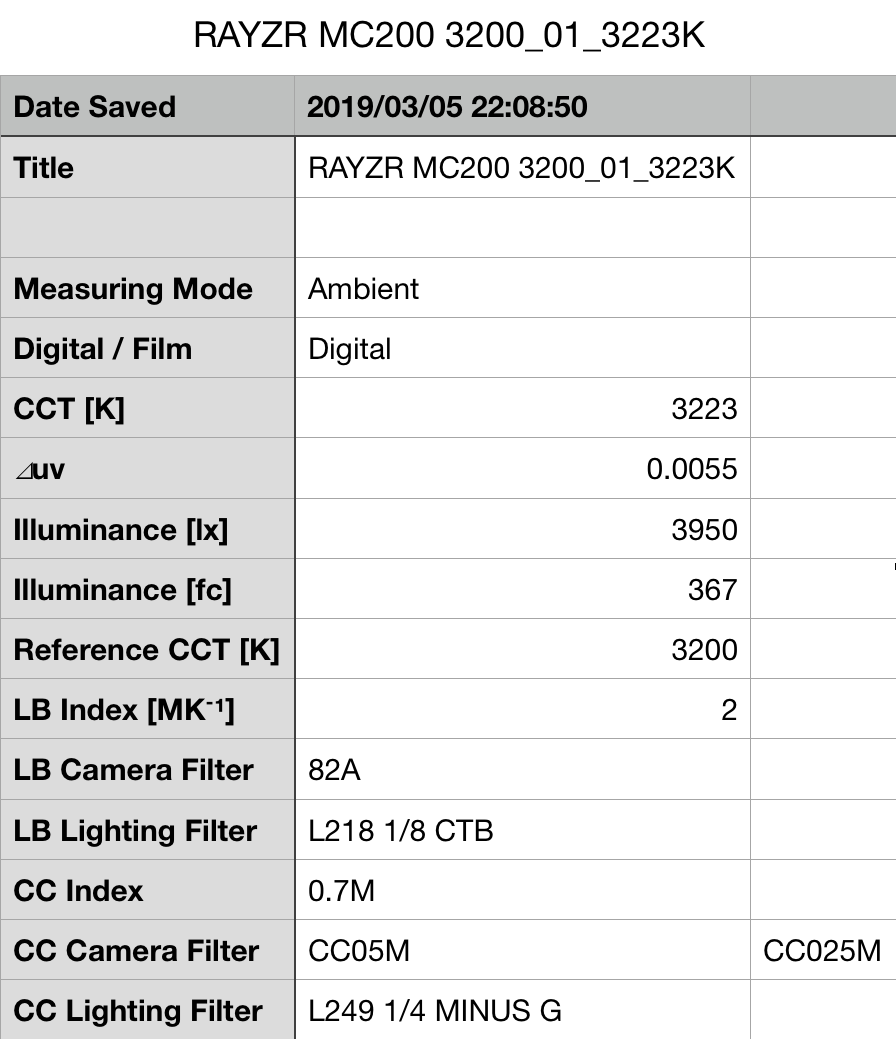
At 3200k, the MC 200 had an output of 3950 lx (367 fc). This was higher than the claimed output of 3835lx. The MC 200 produced a Kelvin color temperature of 3223K. The light had a CC Index score of 0.7M.
Color Rendering
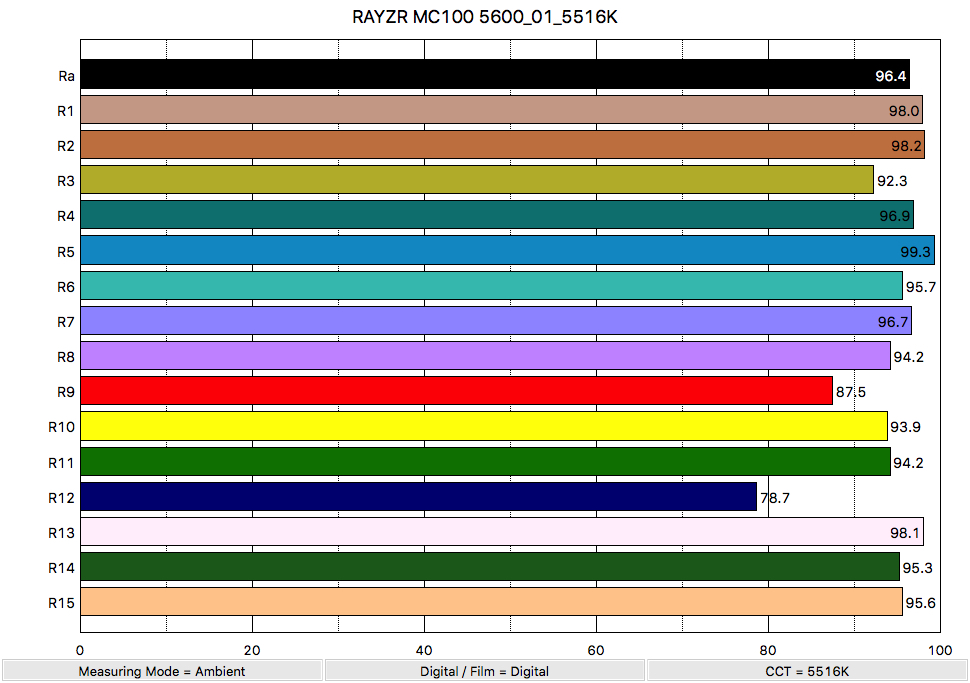
So now that we have seen how much output the MC 100 produces, how does it perform when it comes to replicating accurate colors. Above you can see that when the light was set at 5600K it recorded an average CRI (R1-R8) of 96.4 and an extended CRI (R1-R15) of 94.30. For replicating accurate skin tones it recorded for R9 87.5 (red), 98.1 for R13 (closest to caucasian skin tones), and 95.6 for R15 (closest to Asian skin tones). These are pretty good results.
I also tested the larger MC 200 at 5600K and it recorded an average CRI (R1-R8) of 95.6 and an extended CRI (R1-R15) of 93.80. For replicating accurate skin tones it recorded for R9 92.2 (red), 97.6 for R13 (closest to caucasian skin tones), and 97.3 for R15 (closest to Asian skin tones). Again these were pretty good results and fairly similar to those of the smaller MC 100.
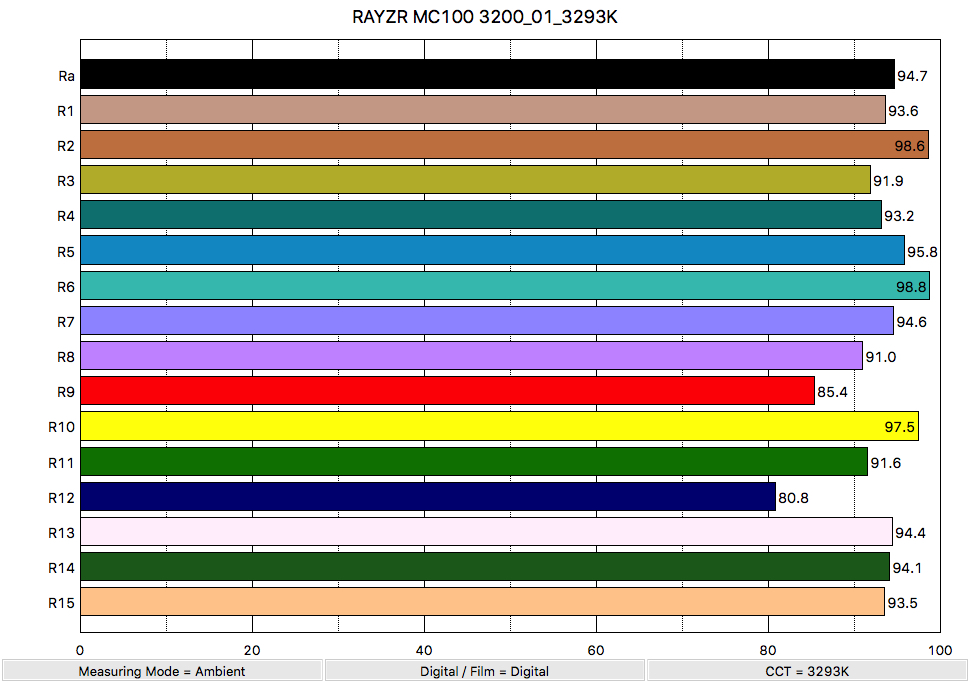
Above you can see the scores for when the light was used at 3200K. It recorded an average CRI (R1-R8) of 94.7 and an extended CRI (R1-R15) of 86.74. For replicating accurate skin tones it recorded 85.4 for R9 (red), 94.41 for R13 (closest to caucasian skin tones), and 93.5 for R15 (closest to Asian skin tones).
These results were not as good as when the light is used at 5600K. While any score in the 90’s is good the performance of the light when used at 3200K isn’t as s good as that at 5600K.
Even though the following lights are larger and draw more power, here is how some other RGBW lights perform at 5600K and 3200K:
5600K
ARRI S30-C SkyPanel – Extended CRI (R1-R15)- 93.39
Lupo Superpanel Full Color 30- Extended CRI (R1-R15)- 93.40
Luxli Timpani- Extended CRI (R1-R15)- 96.20
3200K
ARRI S30-C SkyPanel- Extended CRI (R1-R15)- 93.56
Lupo Superpanel Full Color 30- Extended CRI (R1-R15)- 91.86
Luxli Timpani- Extended CRI (R1-R15)- 95.45
As you can see only the Luxli had better scores than the MC 100 at 5600K, but the other lights were not very far behind. At 3200K all the other lights performed better than the MC 100.
I also tested the larger MC 200 at 3200K and it recorded an average CRI (R1-R8) of 92.1 and an extended CRI (R1-R15) of 90.28. For replicating accurate skin tones it recorded for R9 76.7 (red), 92.4 for R13 (closest to caucasian skin tones), and 91.2 for R15 (closest to Asian skin tones). Again these results and fairly similar to those of the smaller MC 100 when used at 3200K.
Spectral Distribution
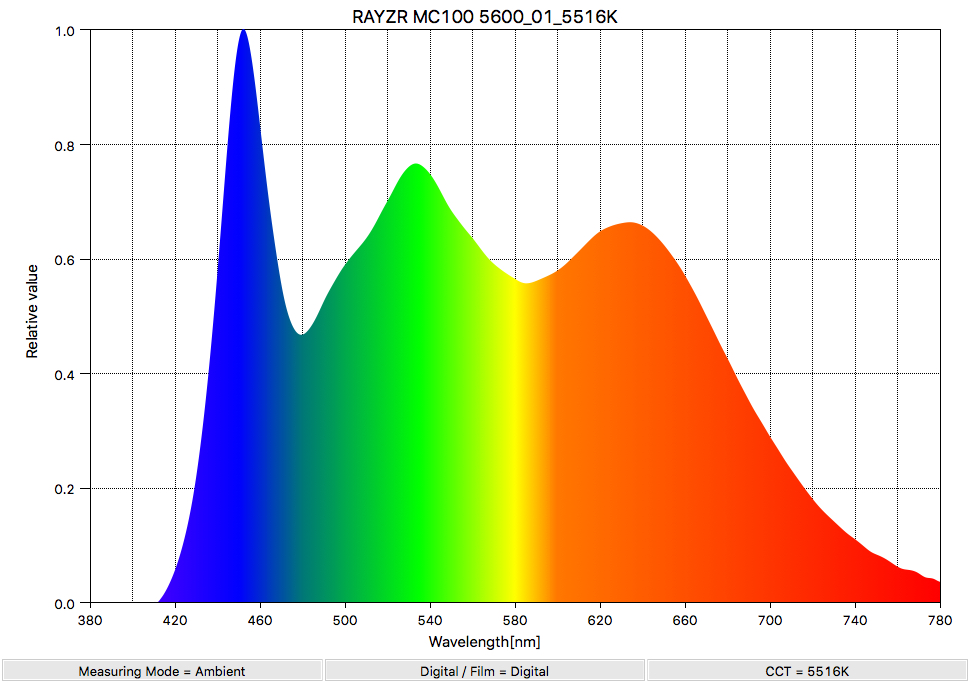
Above you can see the spectral distribution of the MC 120 when it is set at 5600K. The spectral distribution is nice and full at 5600K but the light does have quite a large green spike.
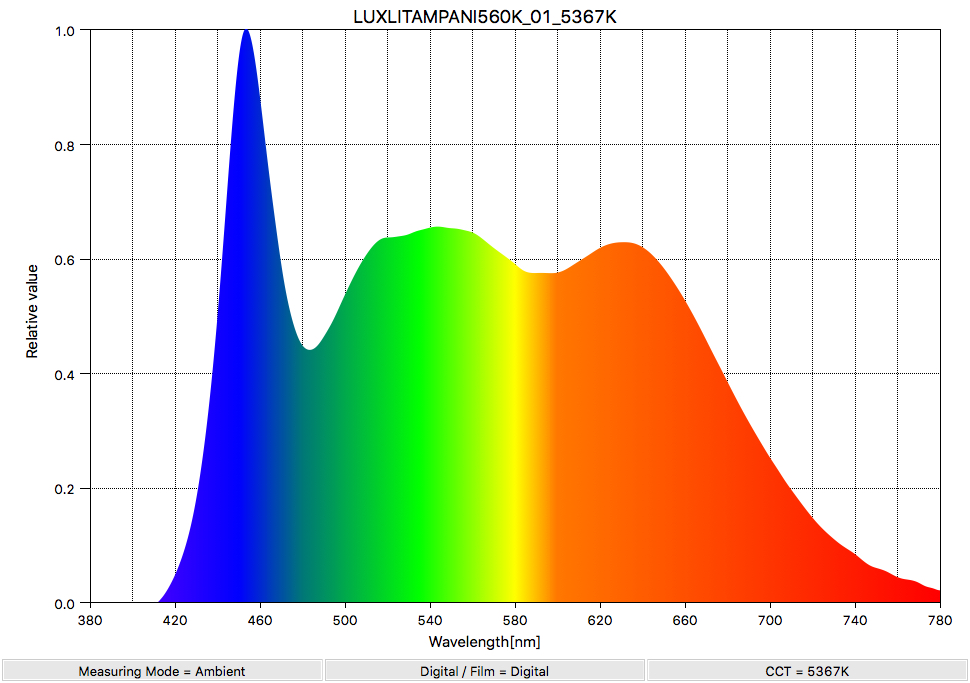
As a comparison, above you can see the spectral distribution of the
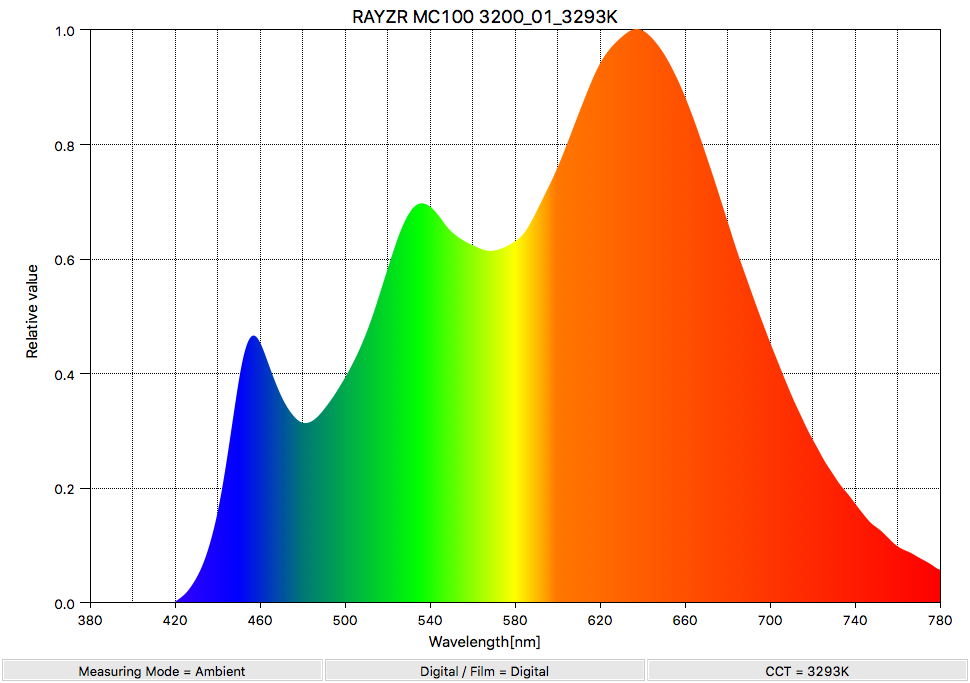
Above you can see the spectral distribution of the MC 100 when it is set at 3200K. Although the spectral distribution is pretty good at 3200K, just like at 5600K it has a green spike.
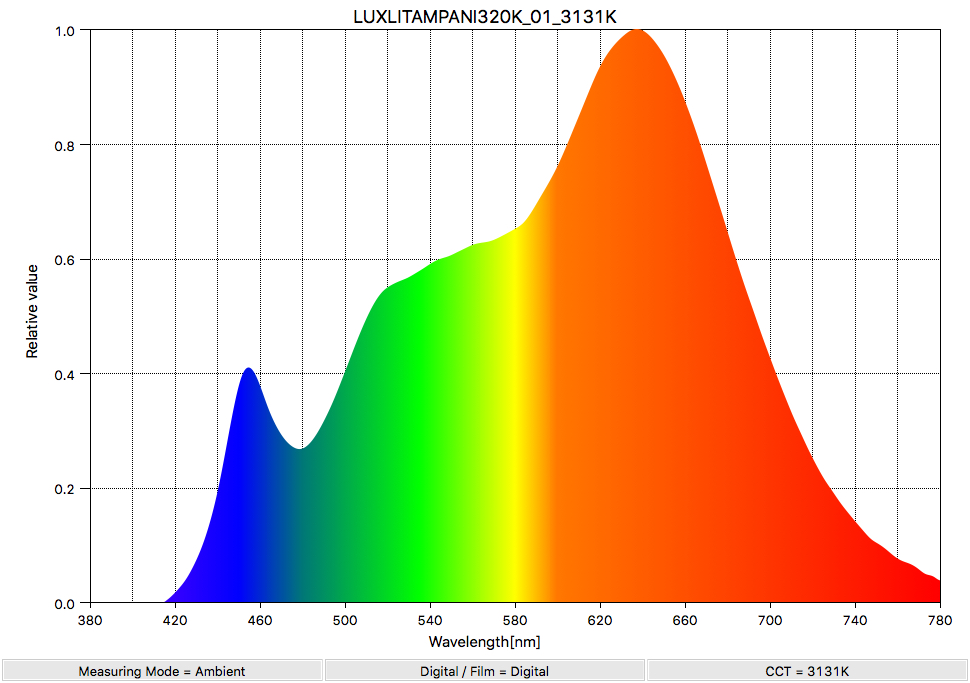
Above you can see the spectral distribution of the
Real World Performance and Quality of Light
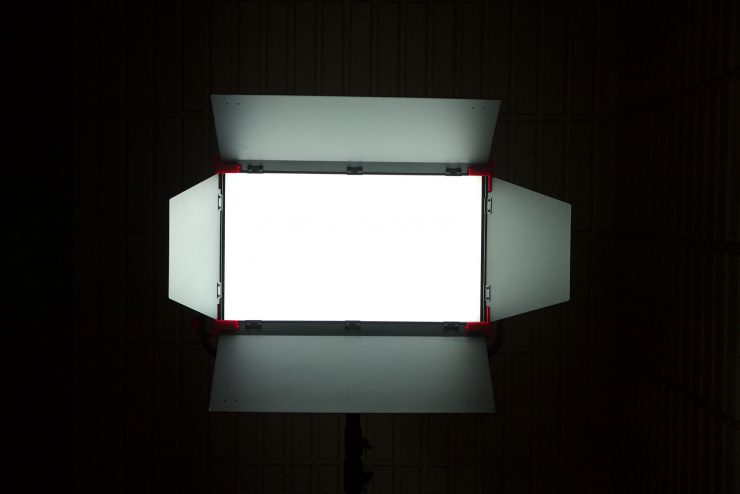
As I always say, photometric scores only tell you part of the story. So do the scores from the MC 120 and MC 200 translate into real-world performance? The simple answer is yes. The quality of the light that is coming from the MC series is pretty much on par with every other 1×1 style RGBWW light I have tested. The soft source being emitted is flattering and you get nice soft shadows.
Above you can see a few simple tests that I did with the MC series. I also compared the MC 120 directly against the Lupo Superpanel Full Color 30, and Luxli Timpani. For the tests, all I did was set the camera to a manual 5600K white balance and then use each of the lights at 5600K.
I did the tests using the lights with no diffusion, and then with two levels of diffusion added. This was to see how they looked and comapred.
These tests were more to see how the lights looked when placed at the exact same distance and height from the subject. I wasn’t so interested in skin tone colors as all of these lights have +/- Green adjustments, and you can manipulate them any way you want. I could hsve also balaned the camera to obtain better results. The shots were not graded, and they were shot directly in a REC.709 color space. The MC series probably lean a little more magenta than the other lights, but you can easily dial this out.
It was interesting to see that all of the lights gave me very similar results in terms of how soft the light looked. There really wasn’t one light that stood out for me.
Considering RGB-WW technology is still in its relative infancy, I was impressed by how well the Rayzr MC panels performed. It’s a very versatile lighting tool that offers a lot of functionality, that doesn’t come at the cost of accuracy. Too often I have seen lights where they have concentrated too much on features and gimmicks which have come at the expense of the quality of light.
While there are a lot of features in the MC series that a good proportion of users may never have the need for, they are still a nice addition to have at your disposal. The key features for me are the CCT Mode (Correlated Color Temperature) where you can add or subtract green and the built-in gels. These are the two real-world features that will be the most commonly used.
Being able to create a range of different colors is cool, and having inbuilt effects like Fire, Lightning, Paparazzi, and Strobe are also fun, but again they are not something most people are going to use that often.
Price
The Rayzr MC panel lights are certainly priced very competitively. Here is what they cost:
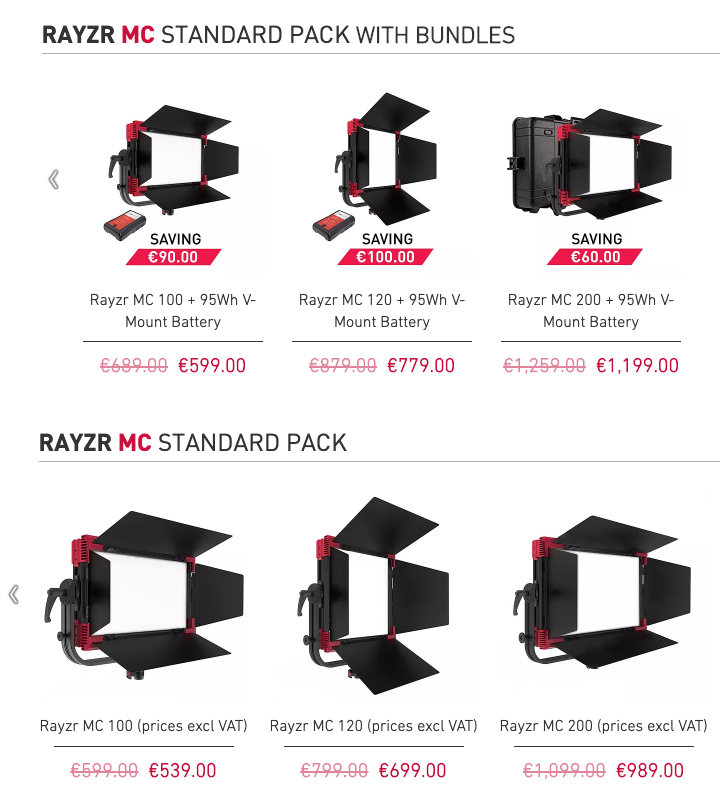
Up until the 4th of April, Rayzr has a special deal on where you can get a free 98Wh battery with every light purchase, or if you prefer you can buy the light at a reduced cost. Above are the deals for the lights with and without the battery.
Who is the MC series aimed at?
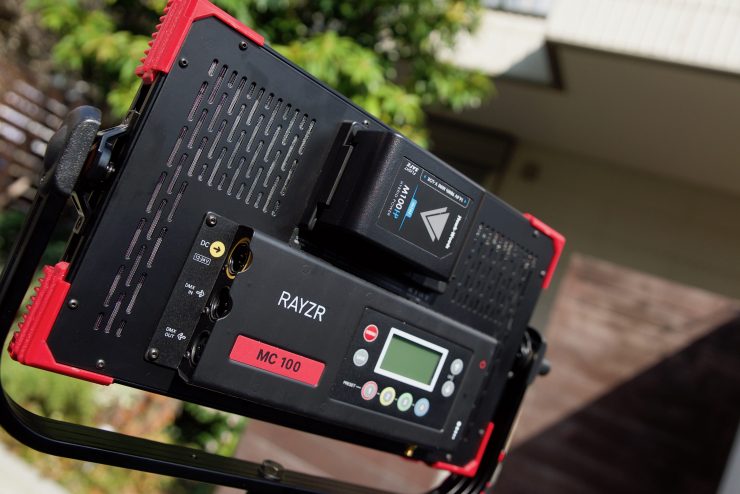
You could use the MC lights for lots of different applications, but they are certainly being targeted as a travel-friendly, power efficient lighting source to take on the road (especially the MC 100 and MC 120). RGBWW panel lights are becoming more and more popular, and we are now starting to see more affordable options enter the market. The MC series is likely to appeal to solo shooters and small crews who are looking for a travel-friendly and affordable RGBWW solution.
Other Alternatives
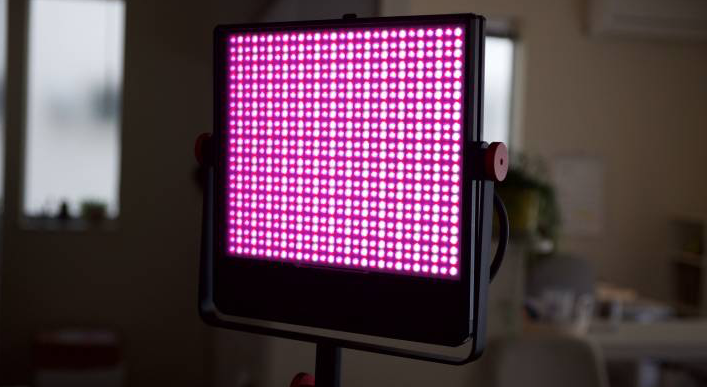
The MC 100 and Mc 200 are a little hard to suggest alternatives to as they aren’t really a traditional size. As far as the MC 120 goes, other alternatives would include the Lupo Superpanel Full Color 30 ($1598 USD), Luxli Timpani (currently available for $899 USD), and the much more expensive BB&S Area 48 Color ($3,300 USD). If you don’t mind slightly larger or heavier fixtures then both ARRI and Kino Flo also have options available.
If you don’t need all the features like Effects Mode, Colour Mode, or even CCT adjustment then there are plenty of other more value-friendly alternatives available.
Conclusion
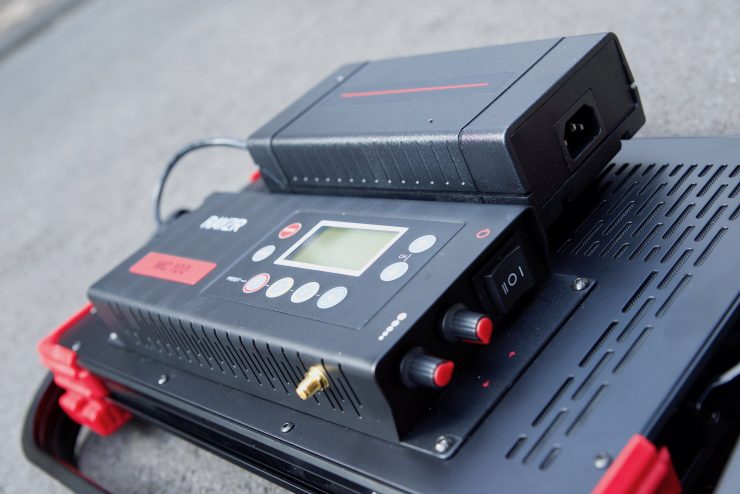
The Rayzr MC series offers very good value for money, and they are substantially more affordable than most other RGBWW lights that are available (except the Luxli Timpani).
The MC series is well built, fully featured and produces a really nice quality of light. The color rendering scores are good and the output is high considering the low power draw.
Do I need these extra features and RGBWW capabilities? Probably not, but they are nice to have. Is it a practical light for solo shooters, yes. I could see myself traveling with either the MC 100 or MC 120. I think the MC 100, in particular, is a great size for anyone who travels, and the fact it can be run off a travel safe battery that is under a 100Wh is a big deal.
I like that the fixtures come with a built-in battery plate and barn doors, and that the yolk frame and locking mechanism are well made.
The MC series is good first out effort for Rayzr who up until now, have only made fresnel LEDs. As I mentioned earlier they offer a good balance of performance and features at a reasonable price.




